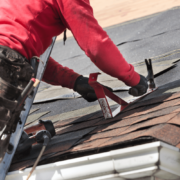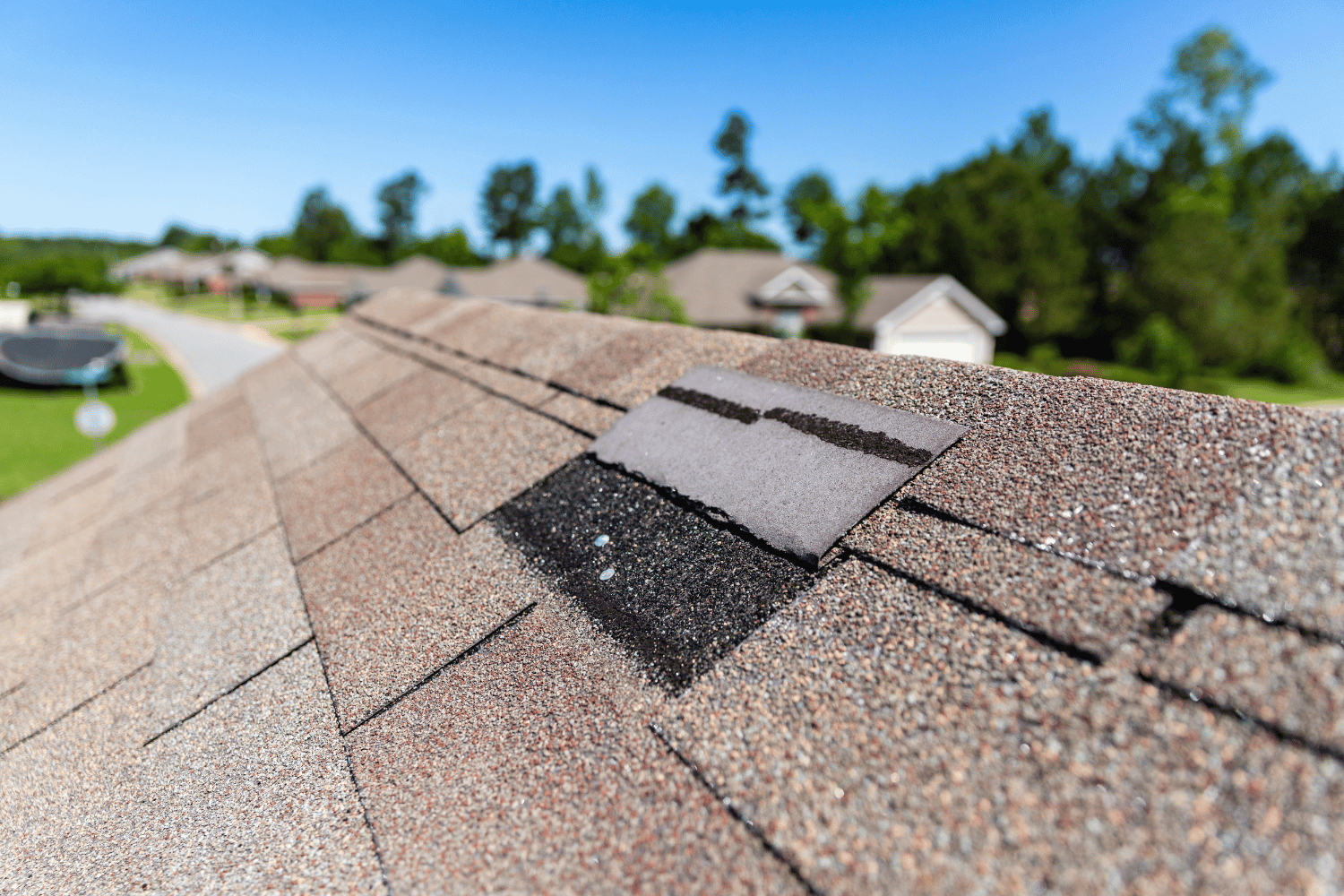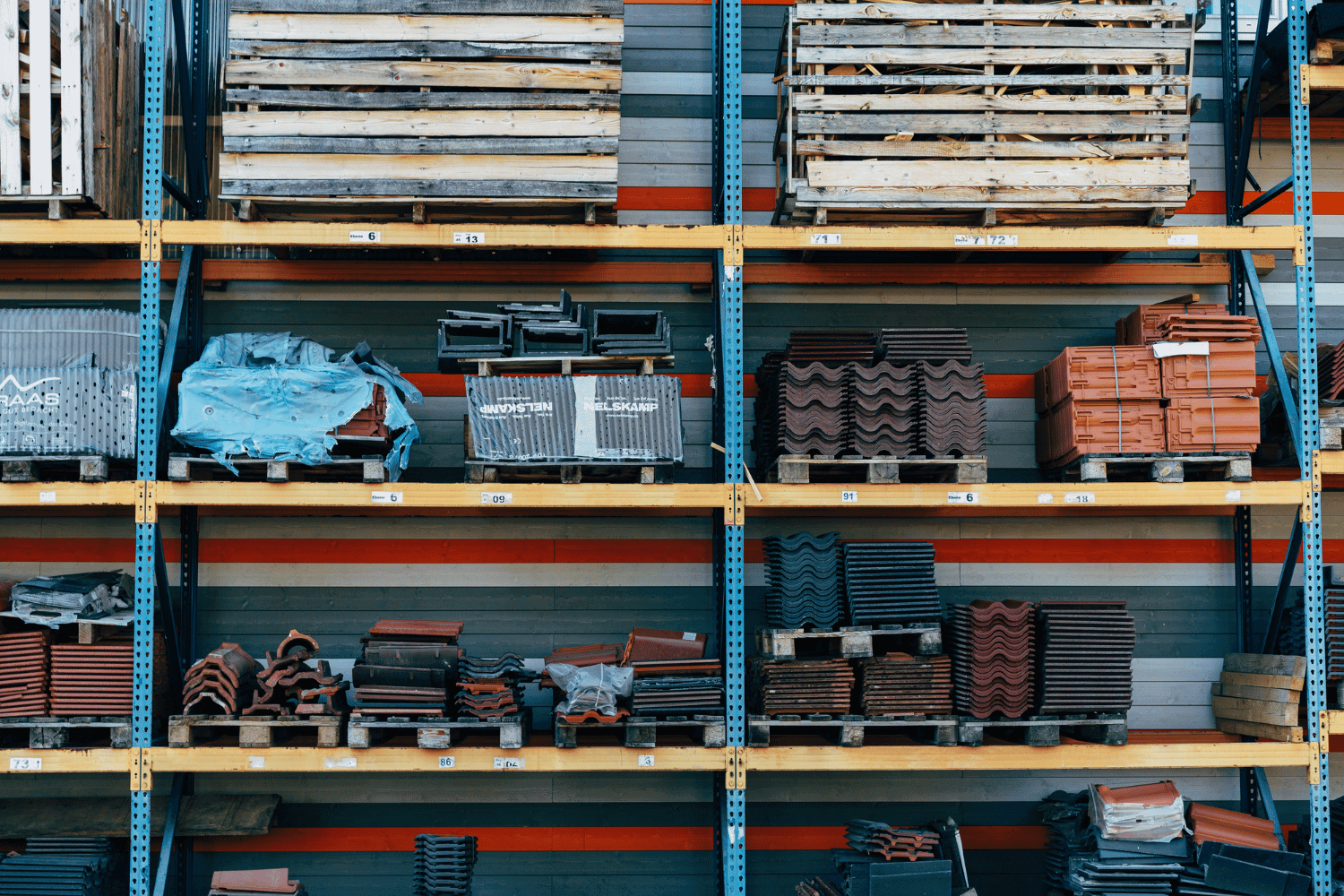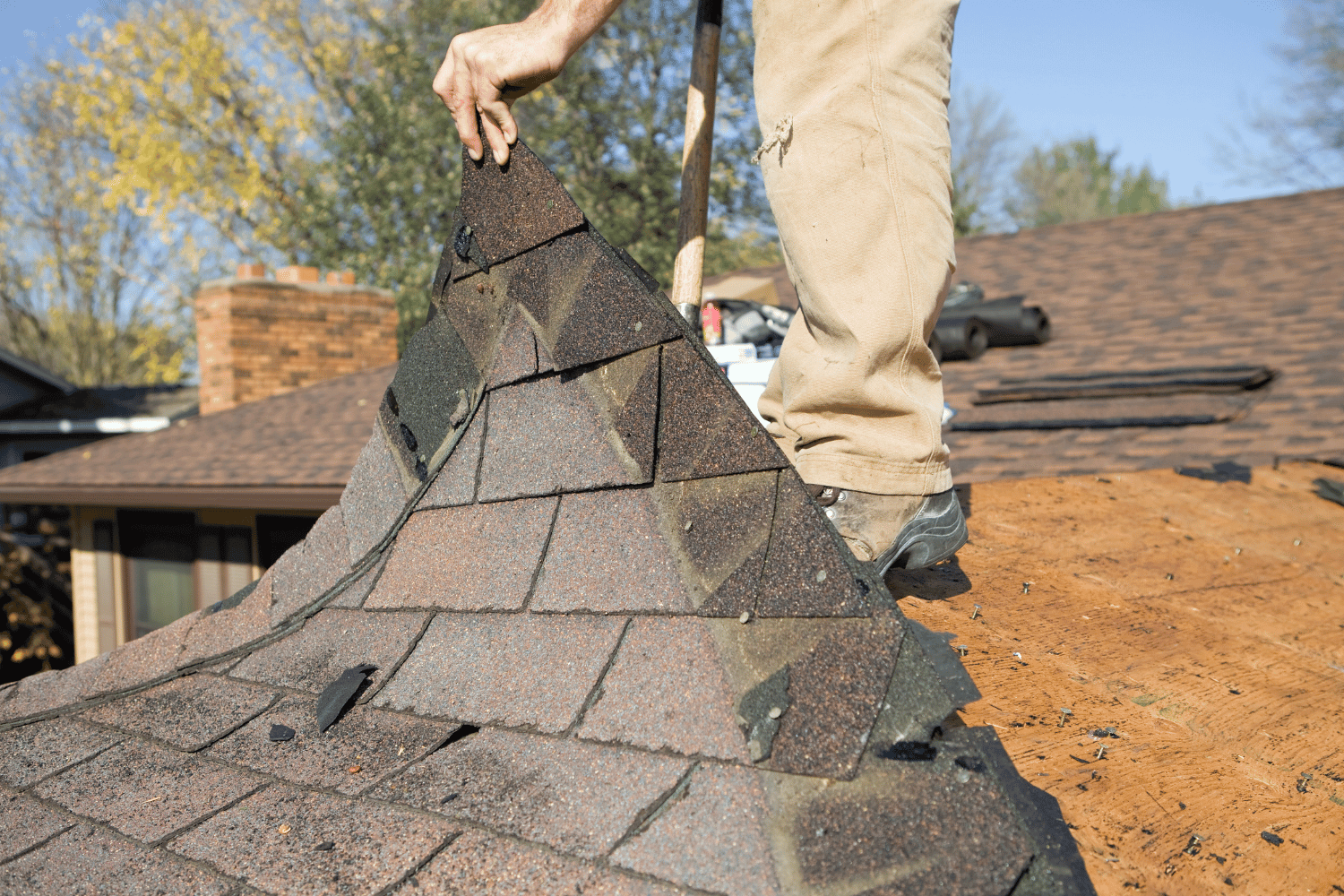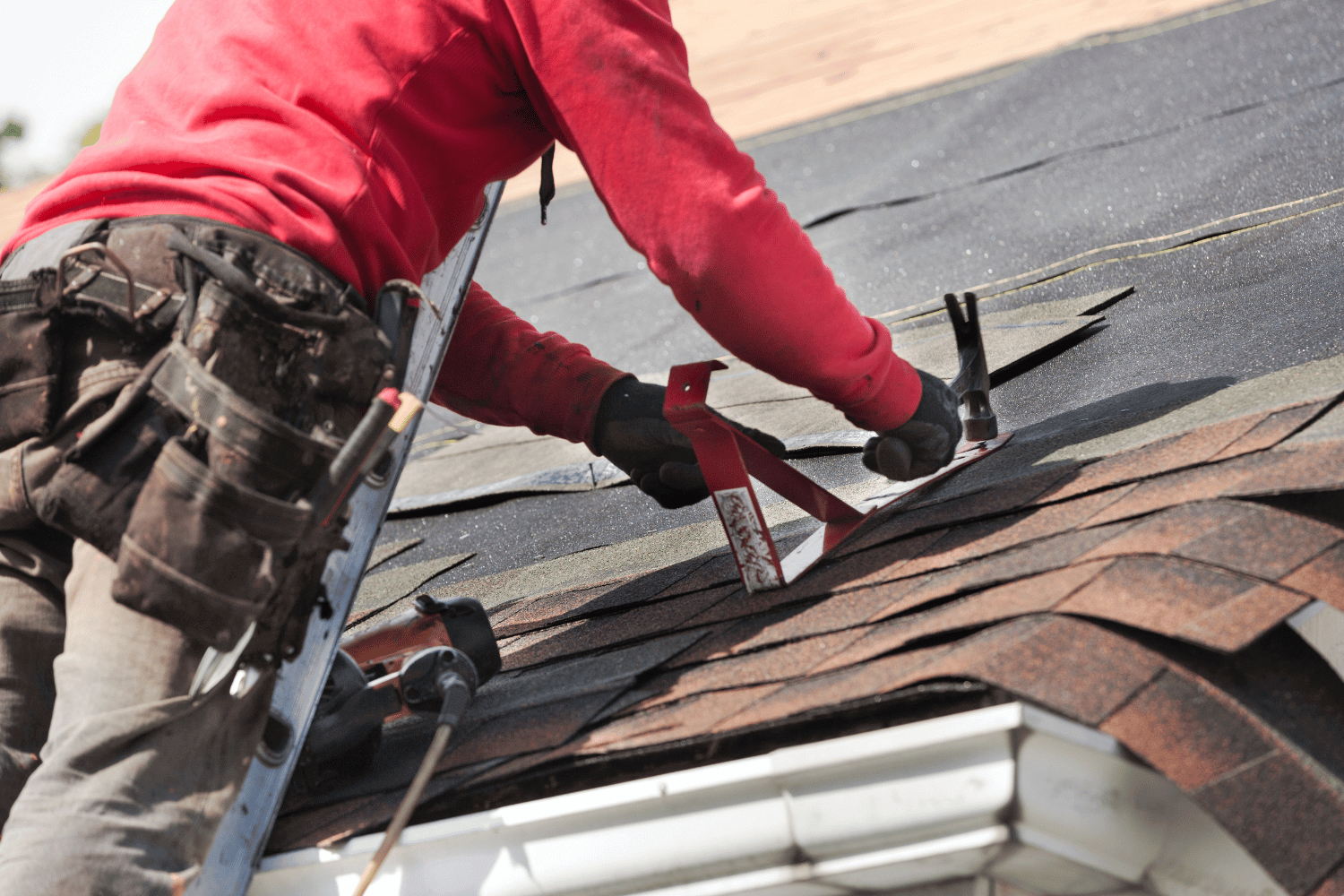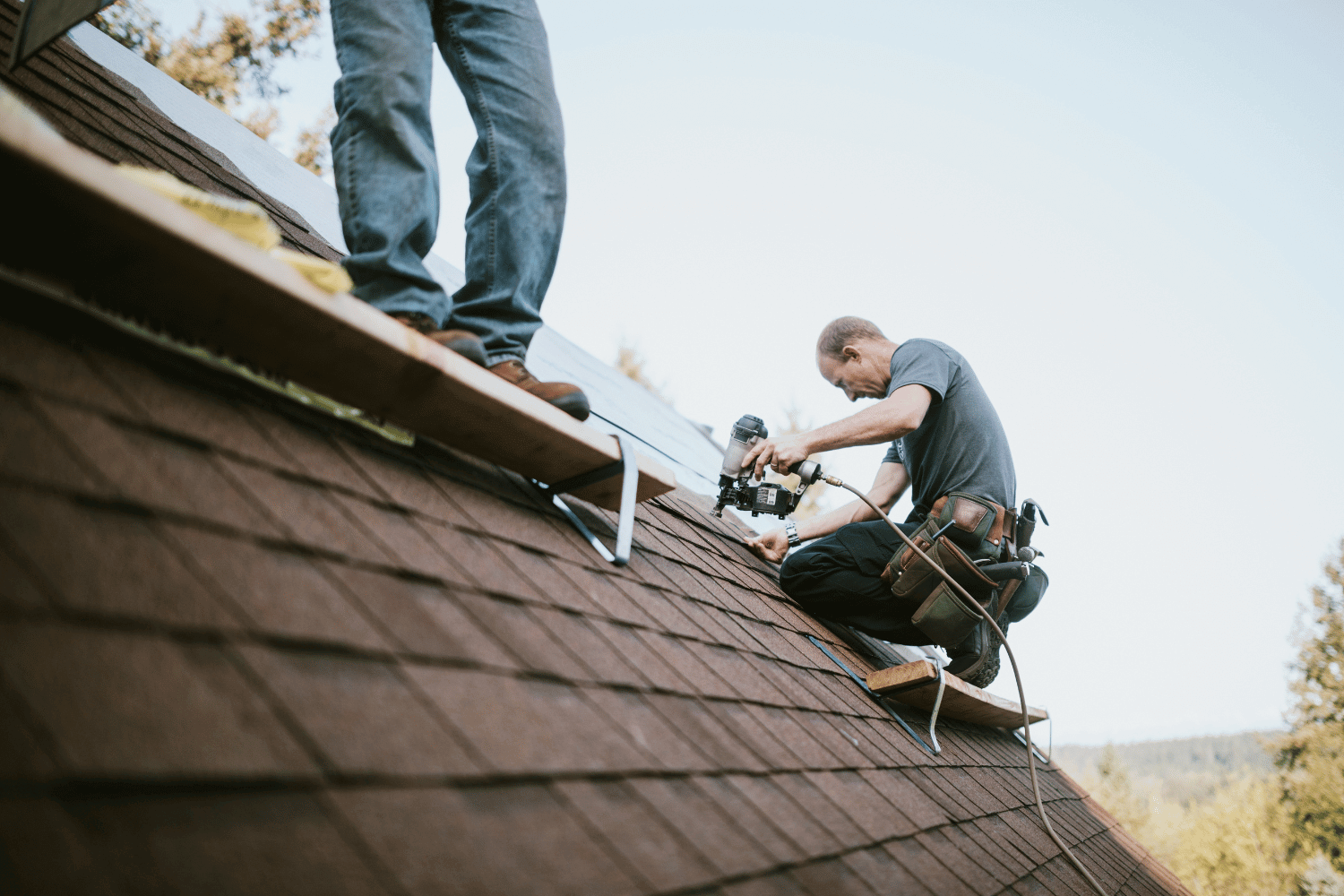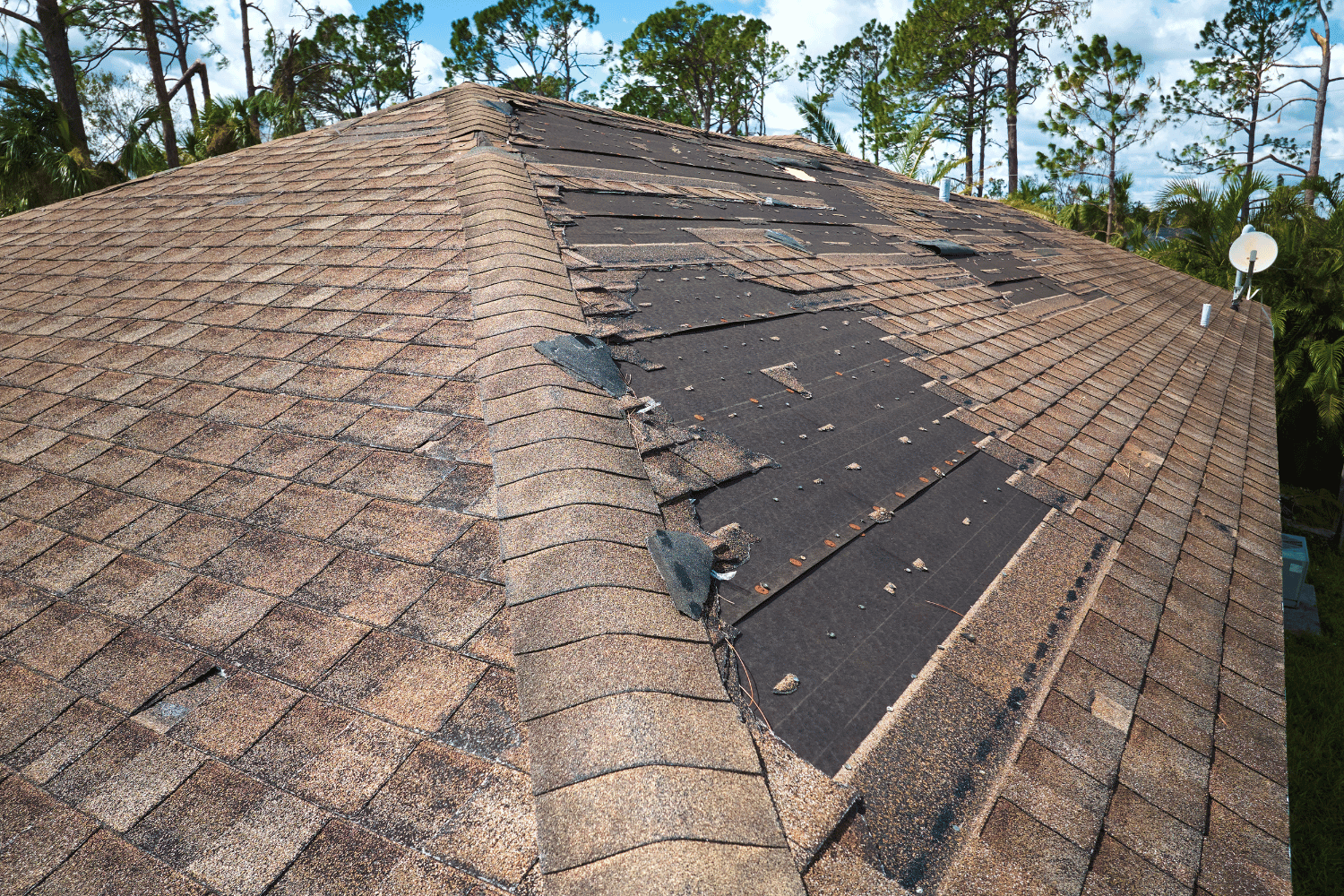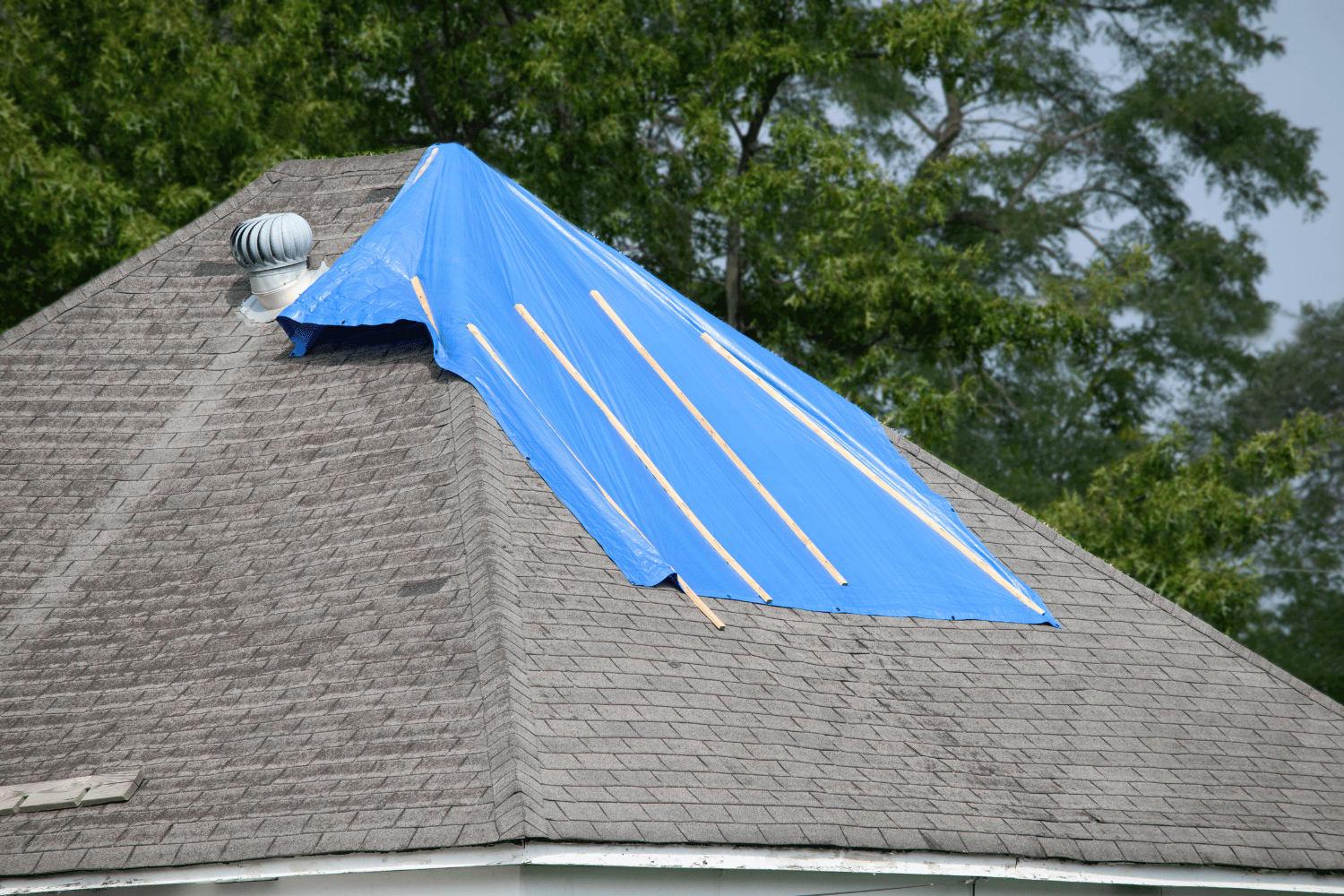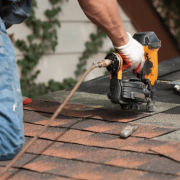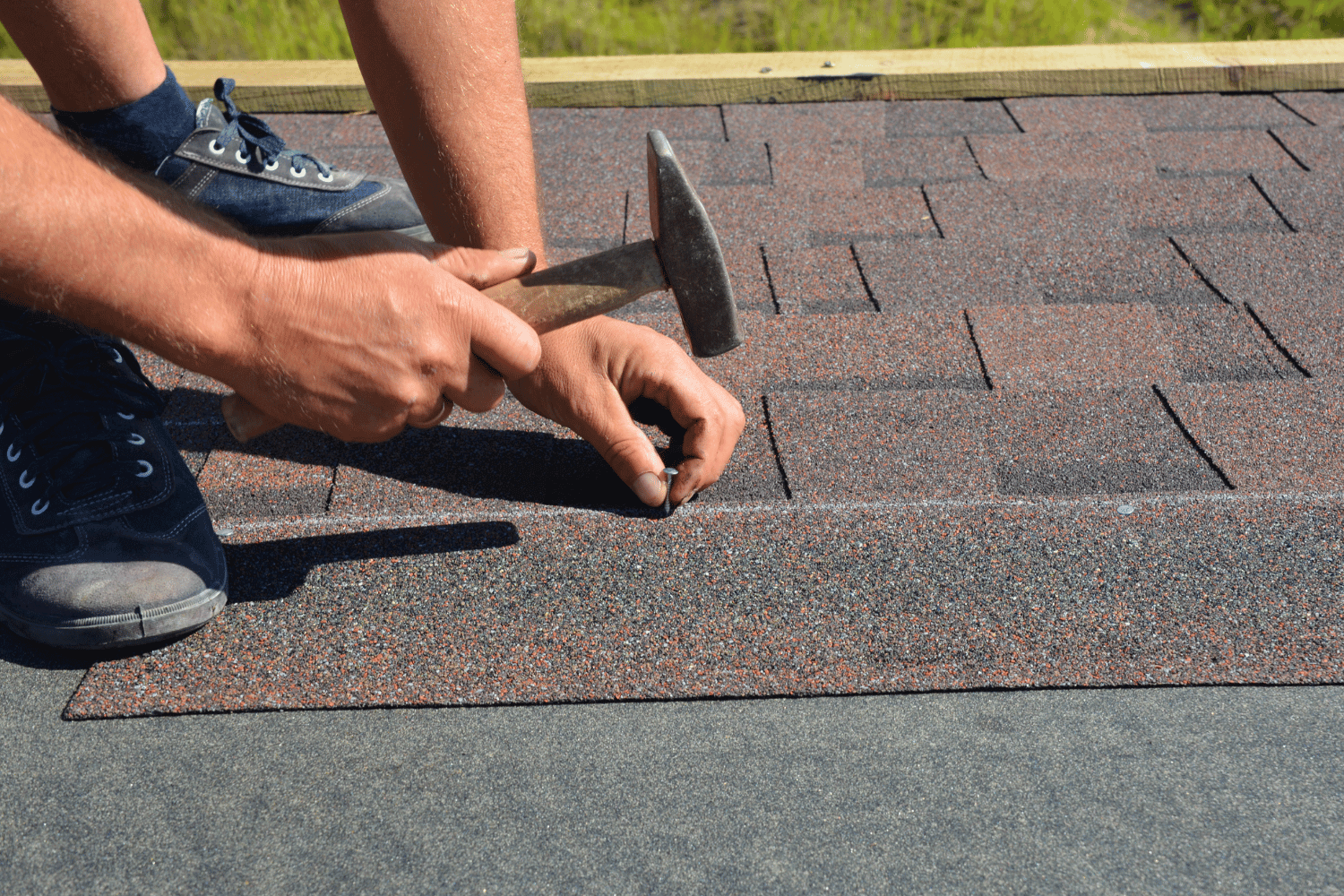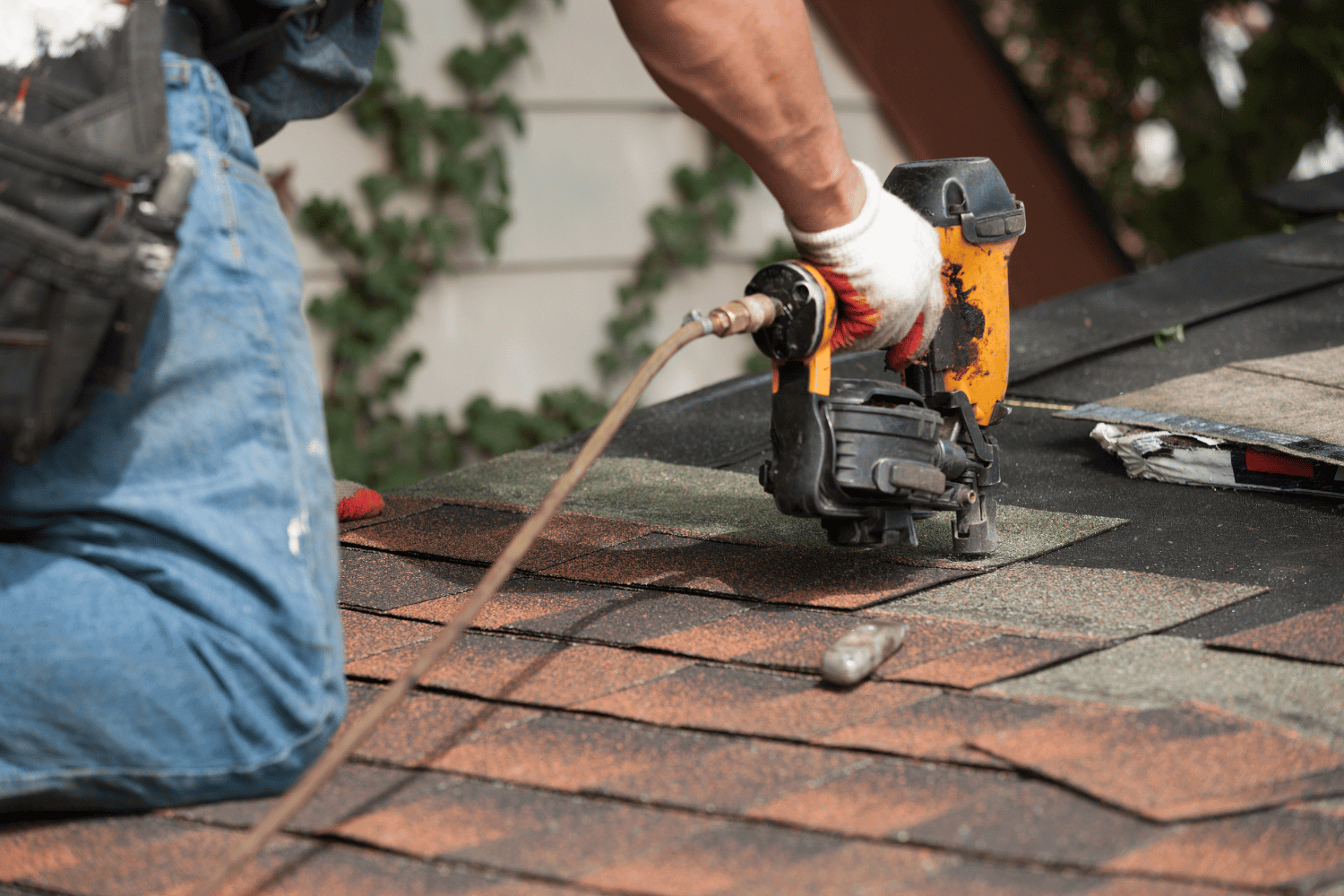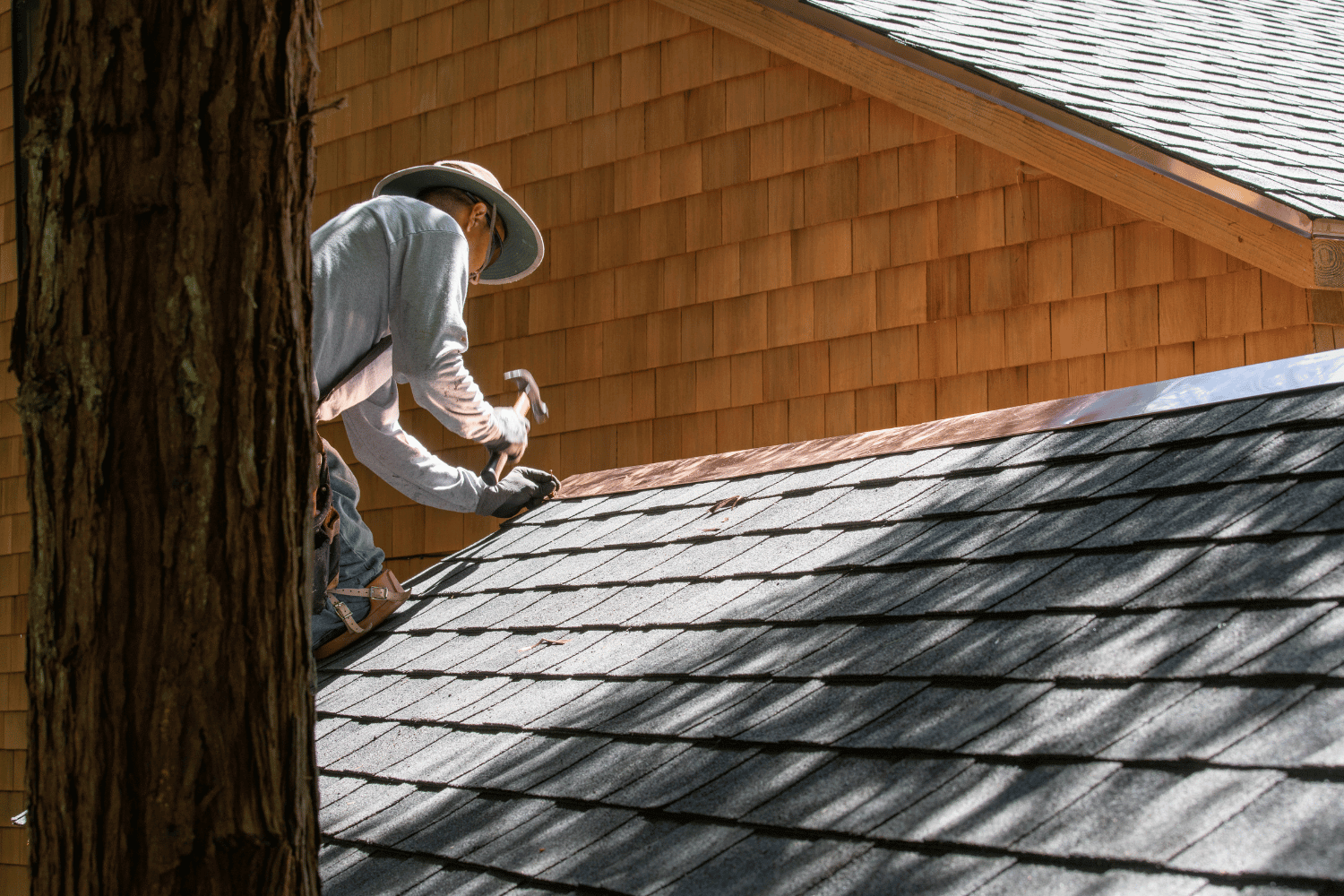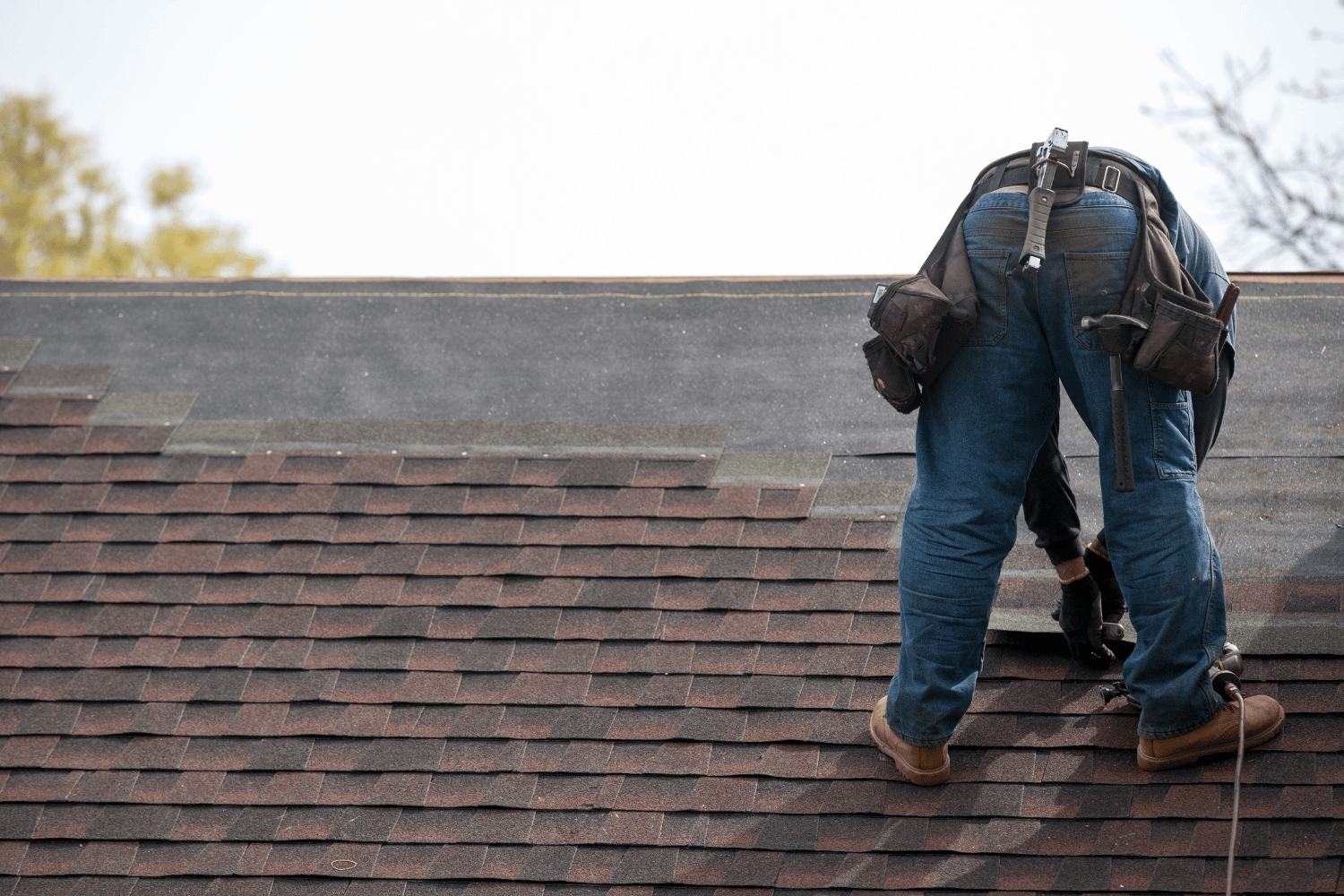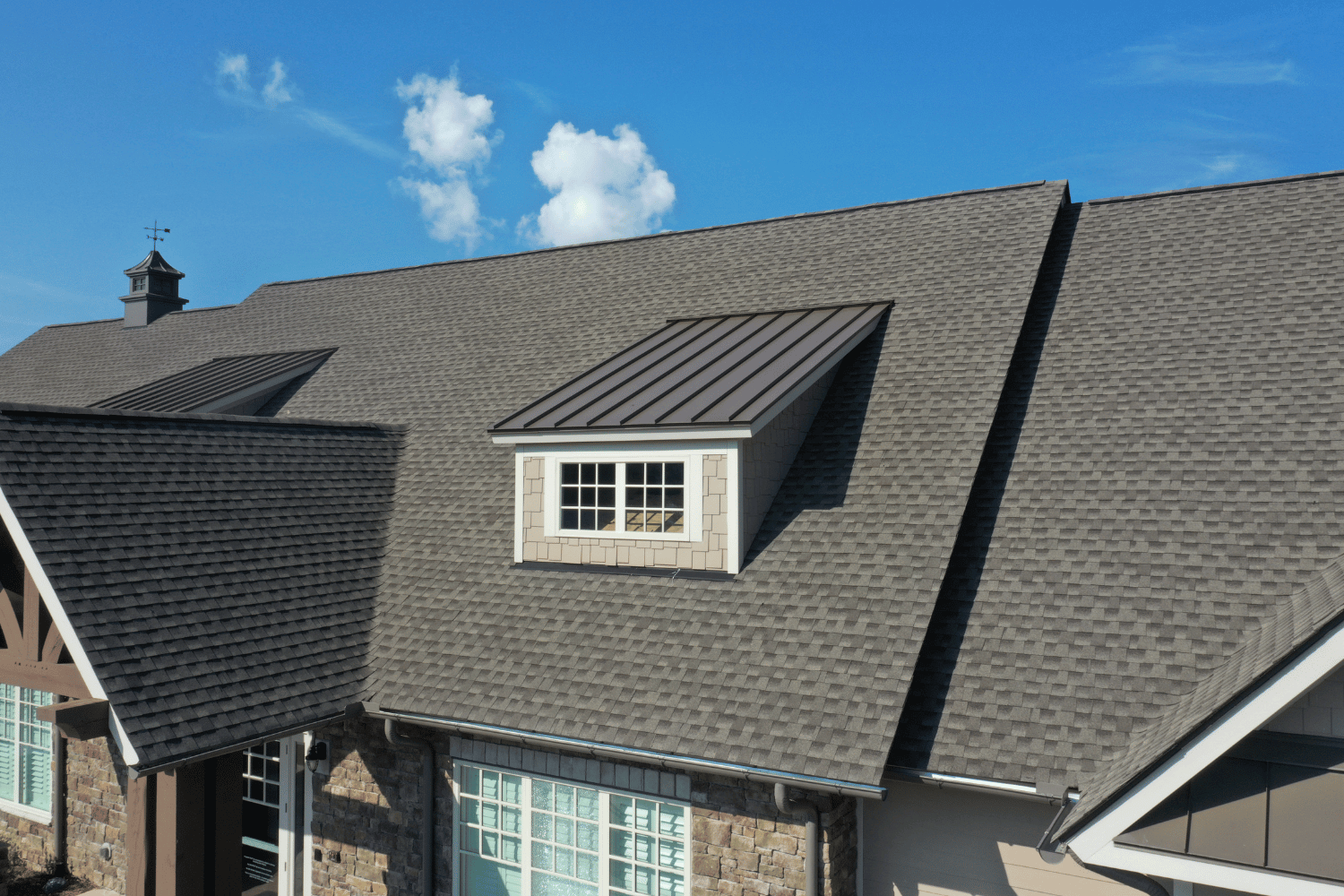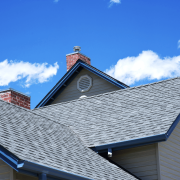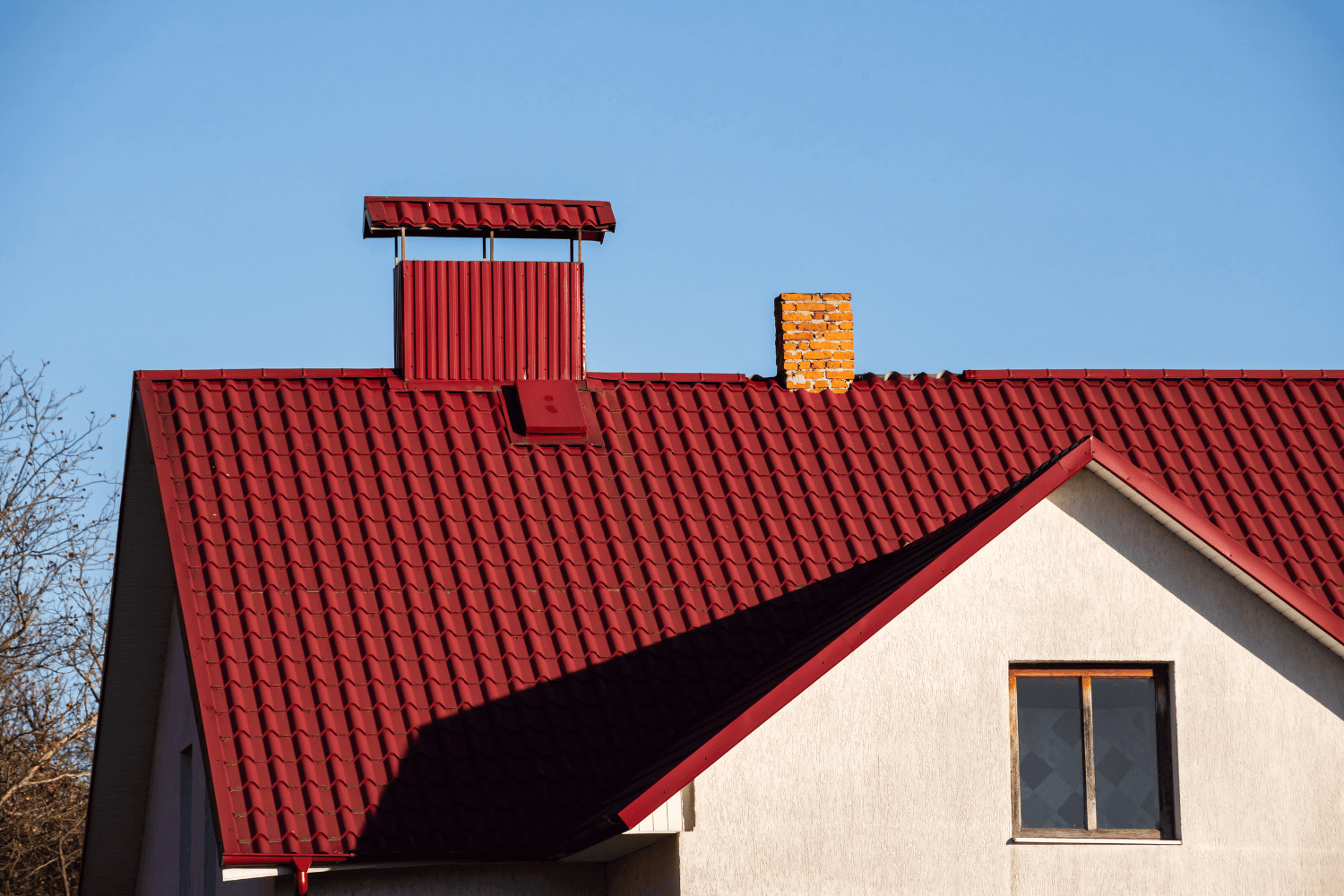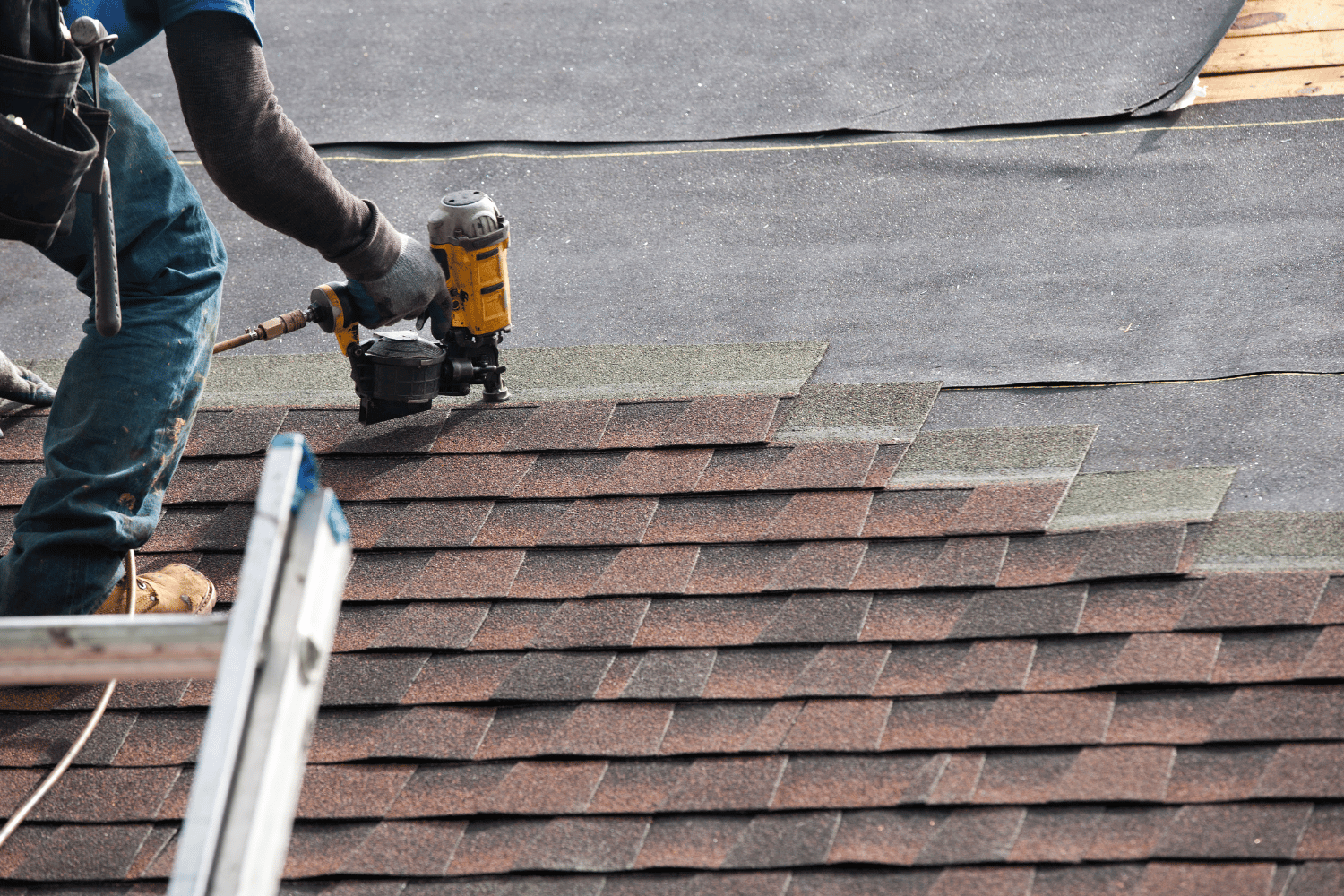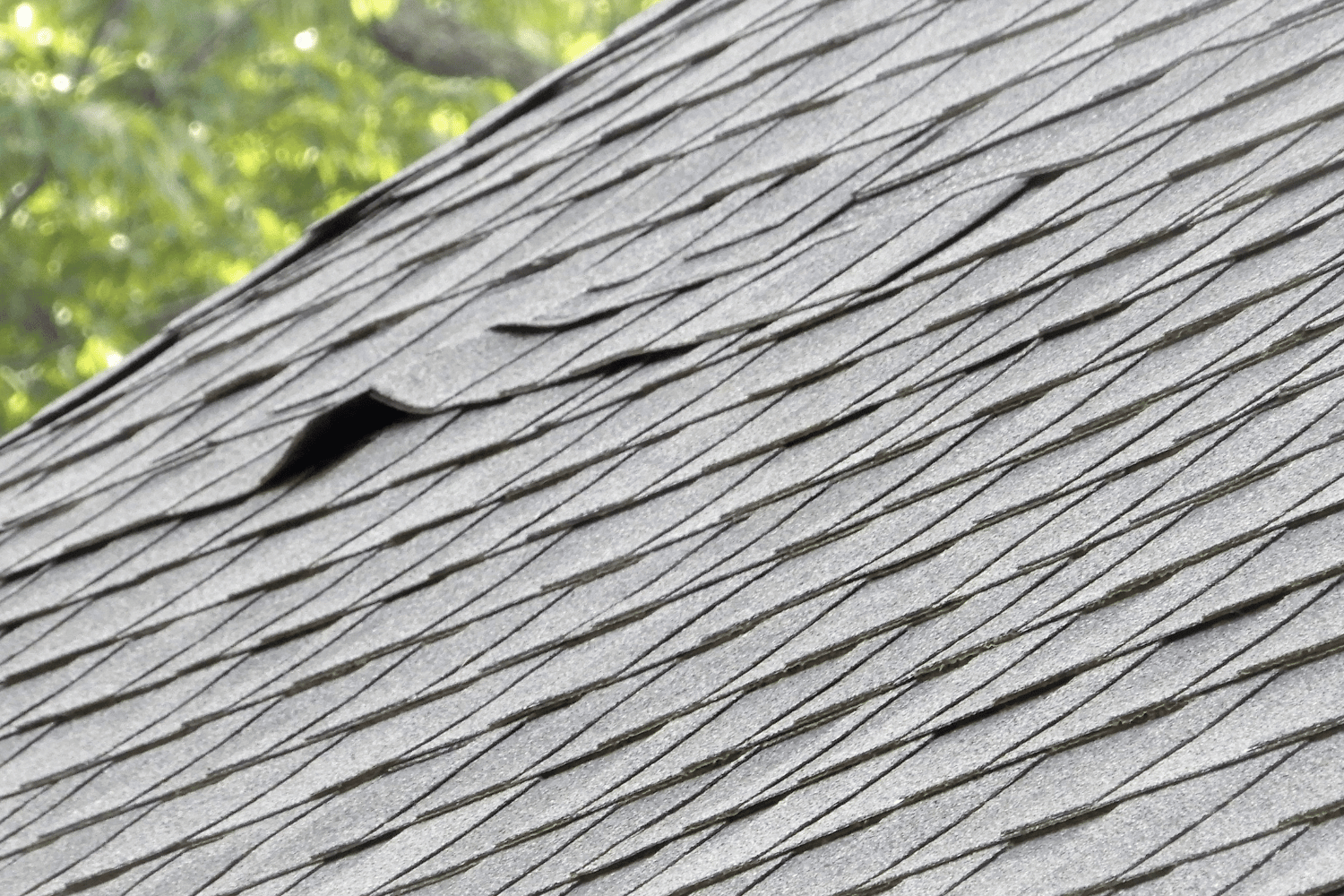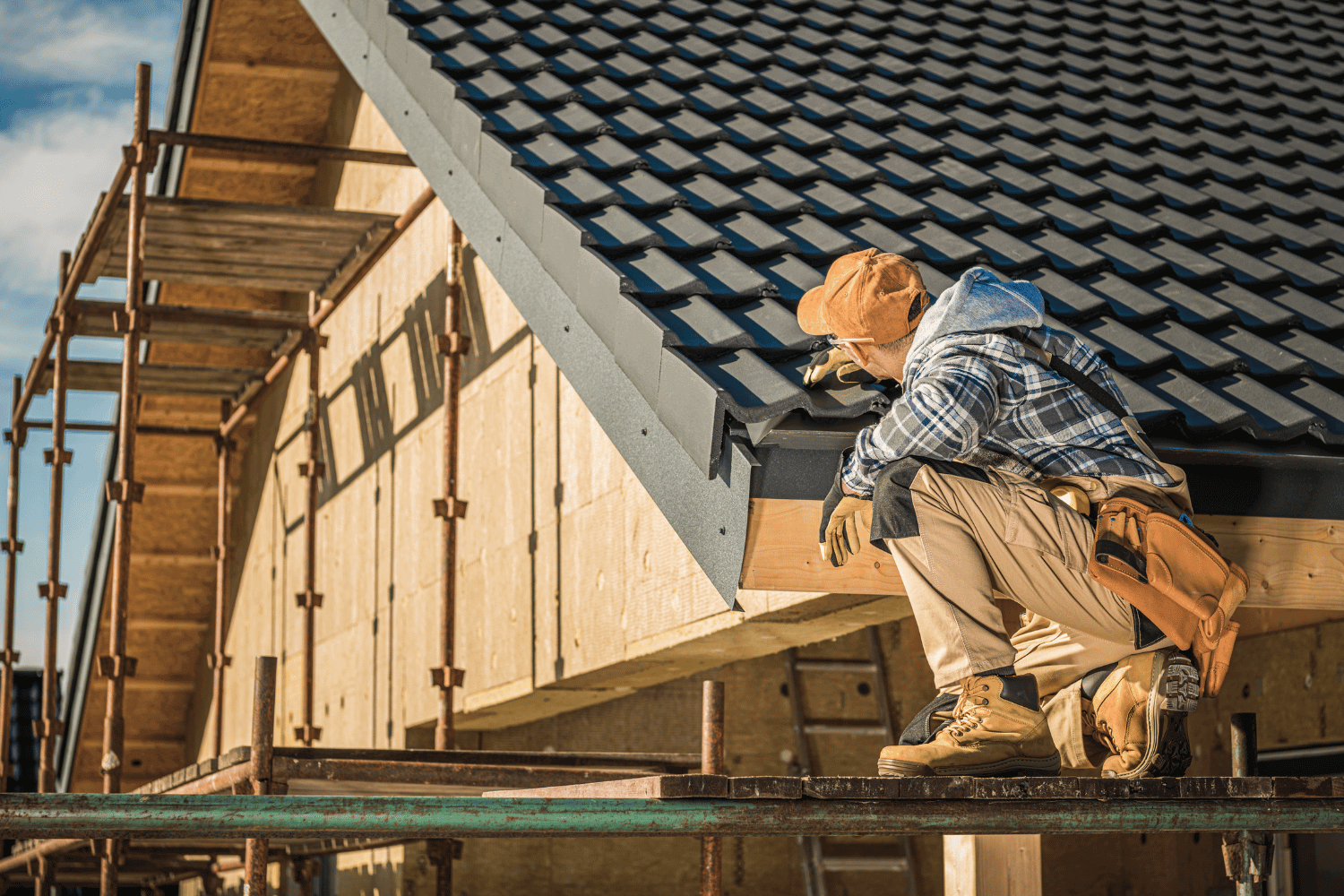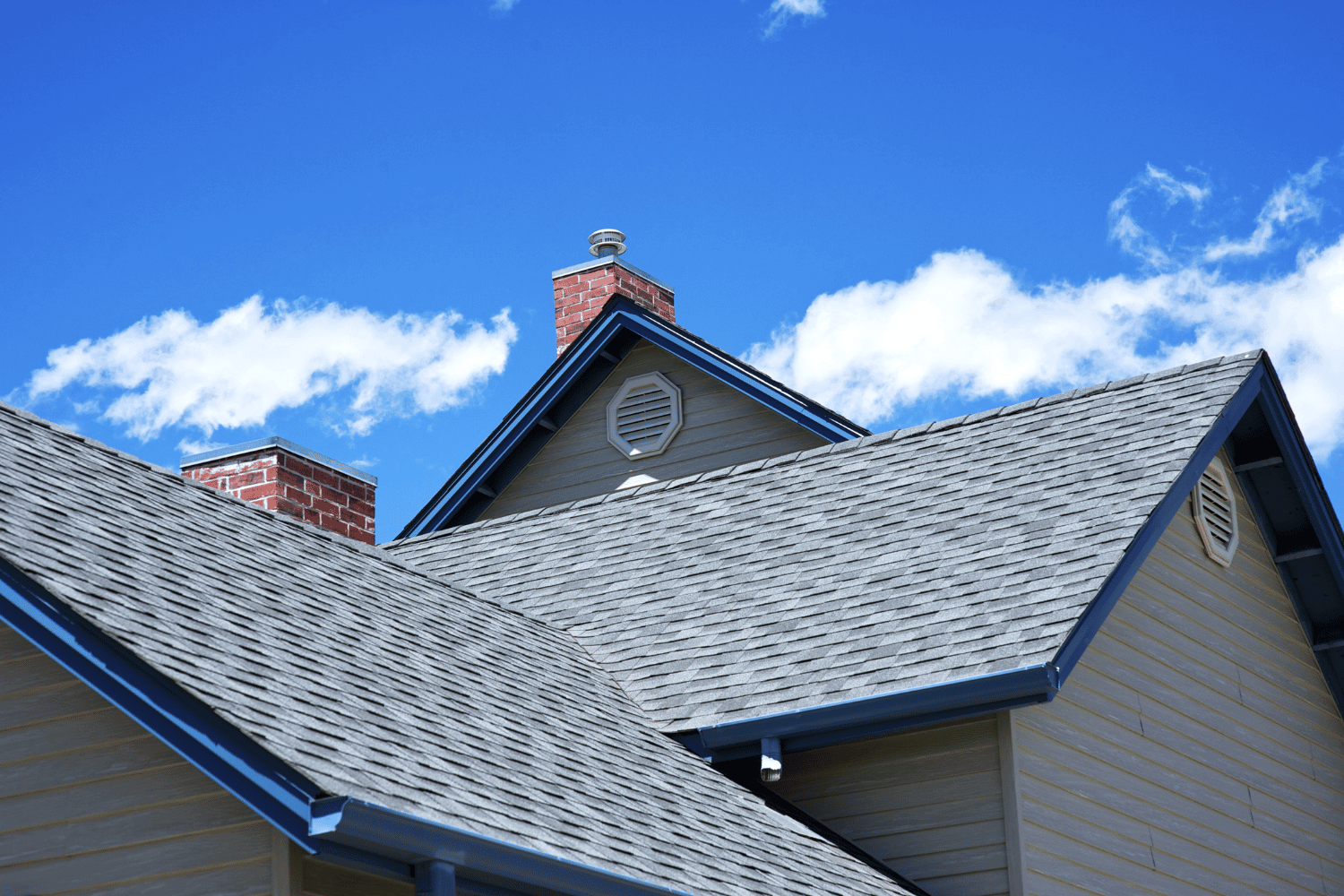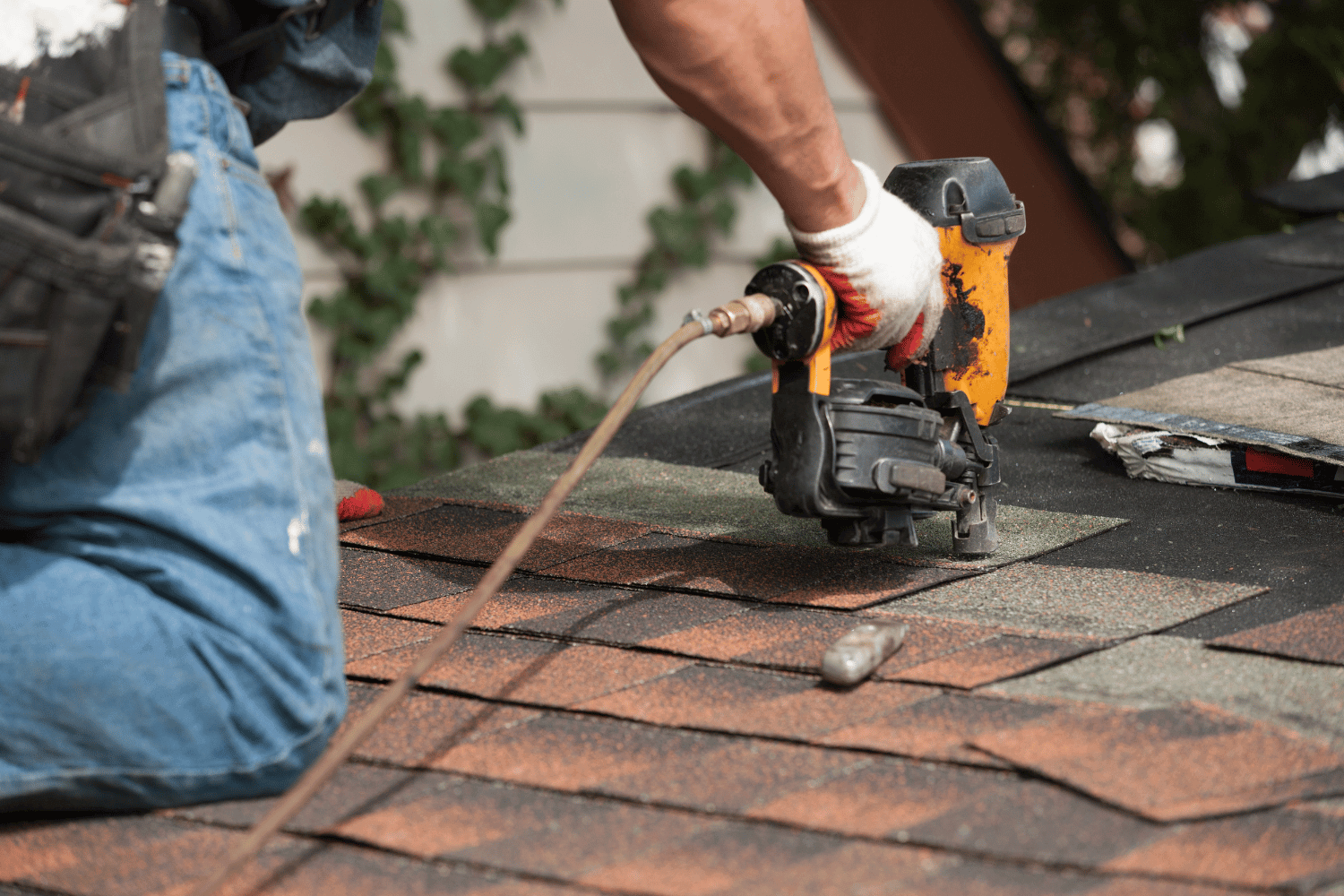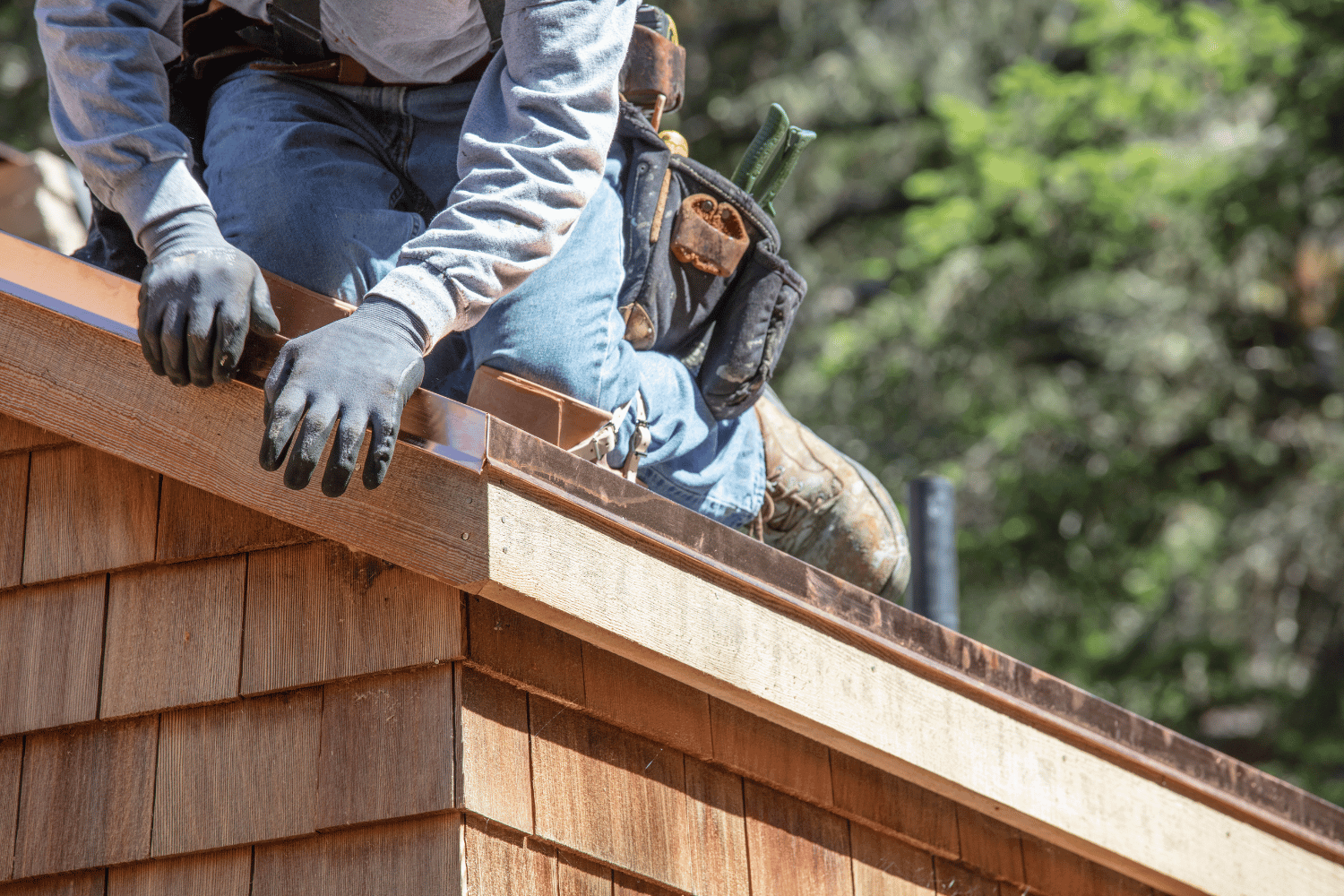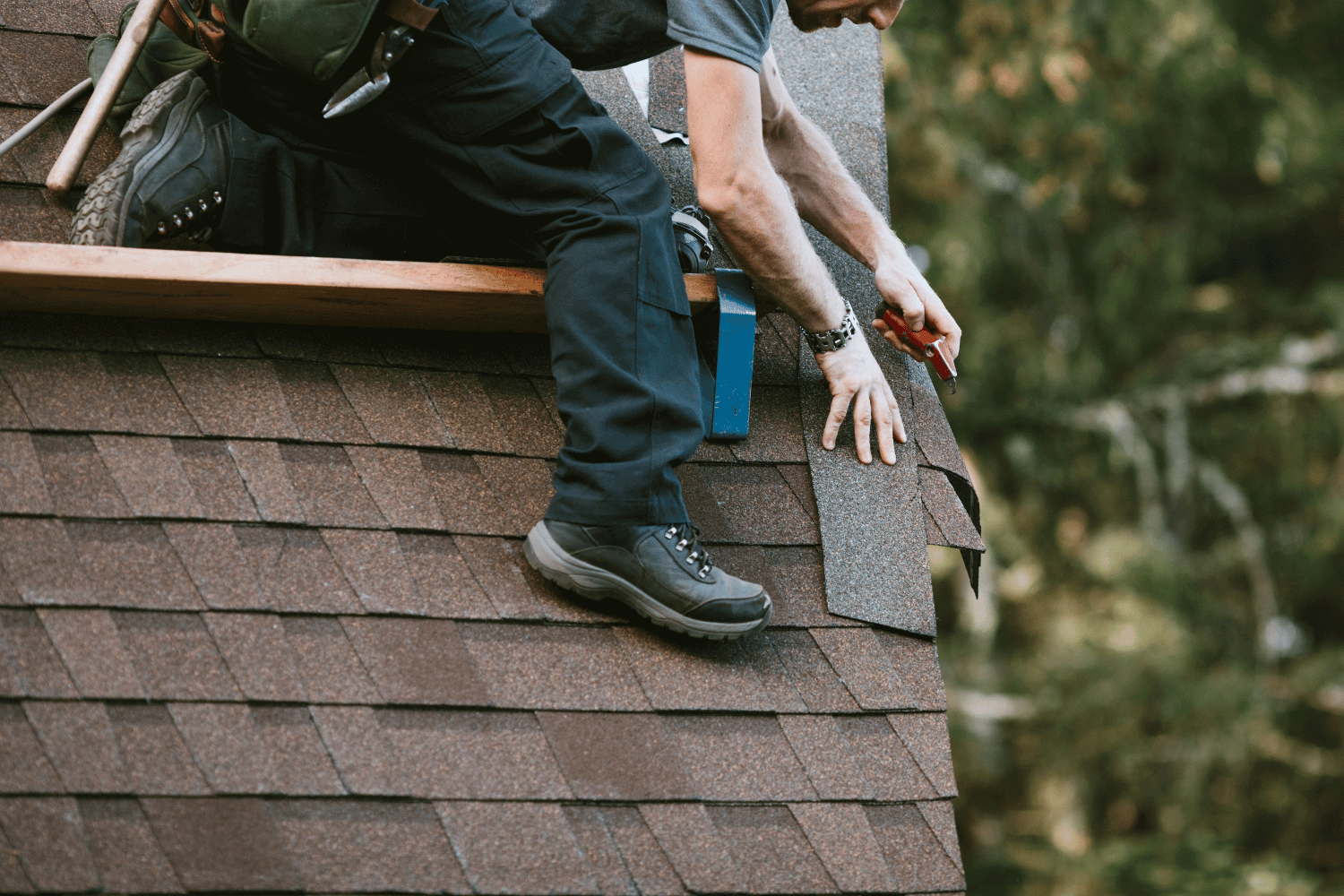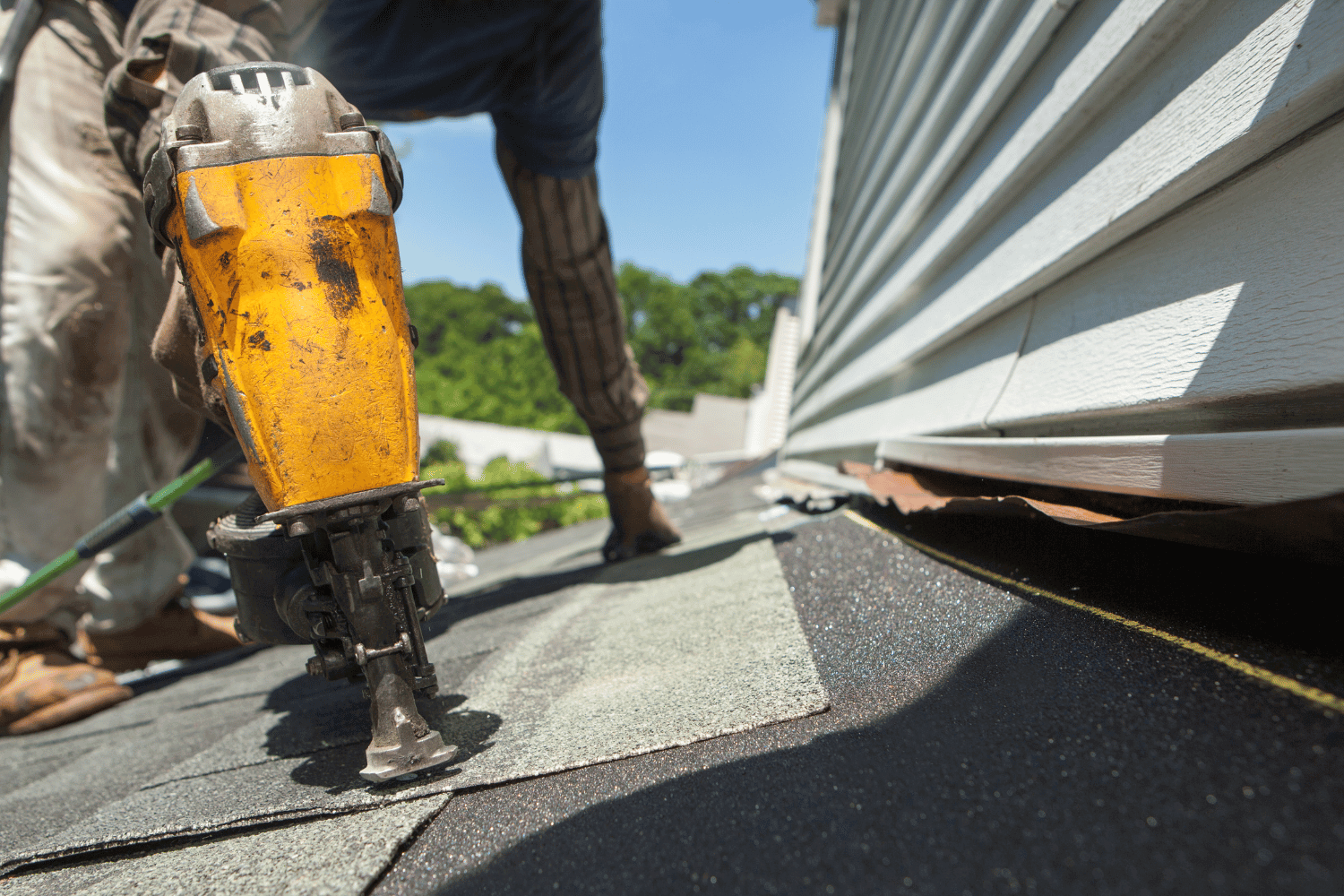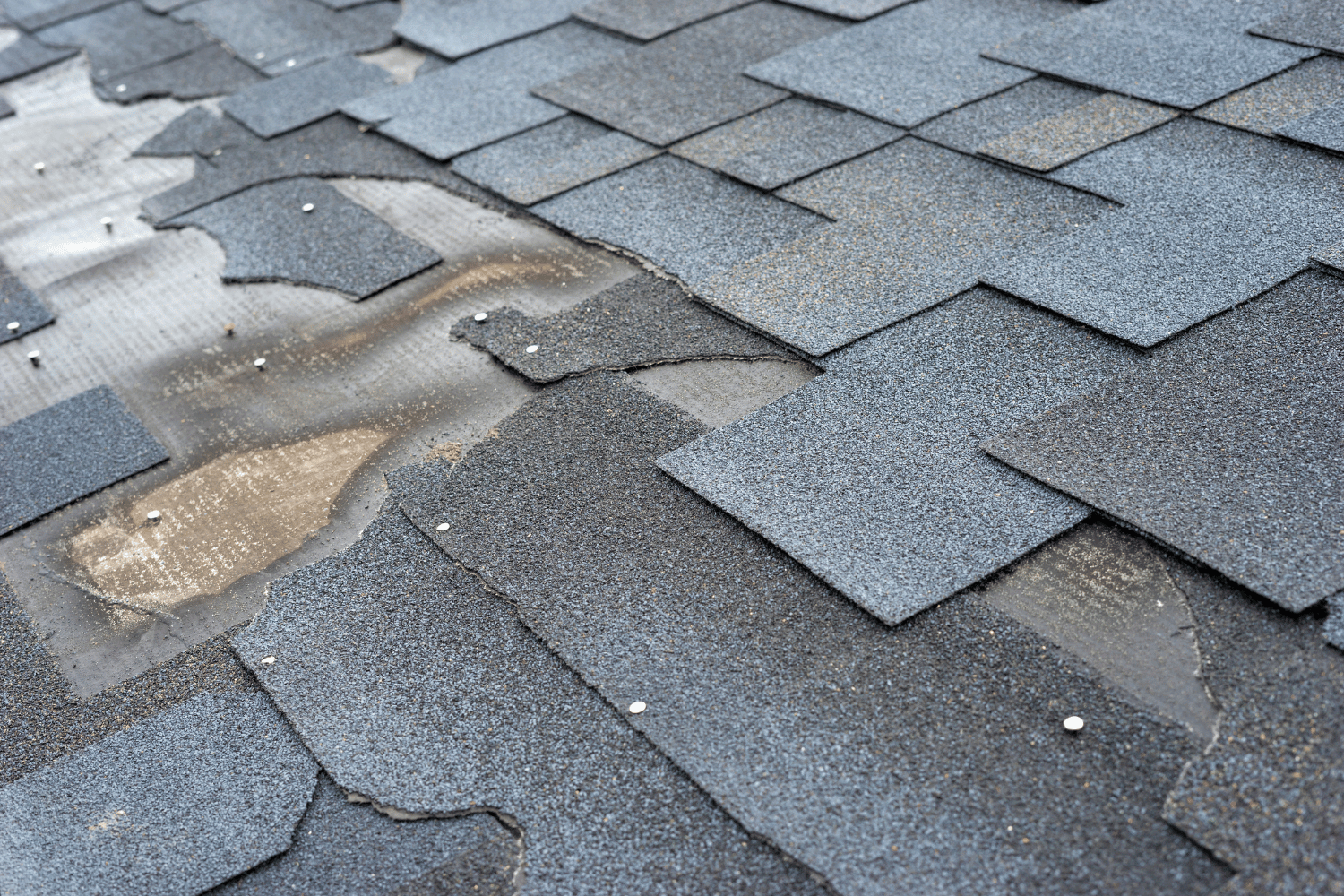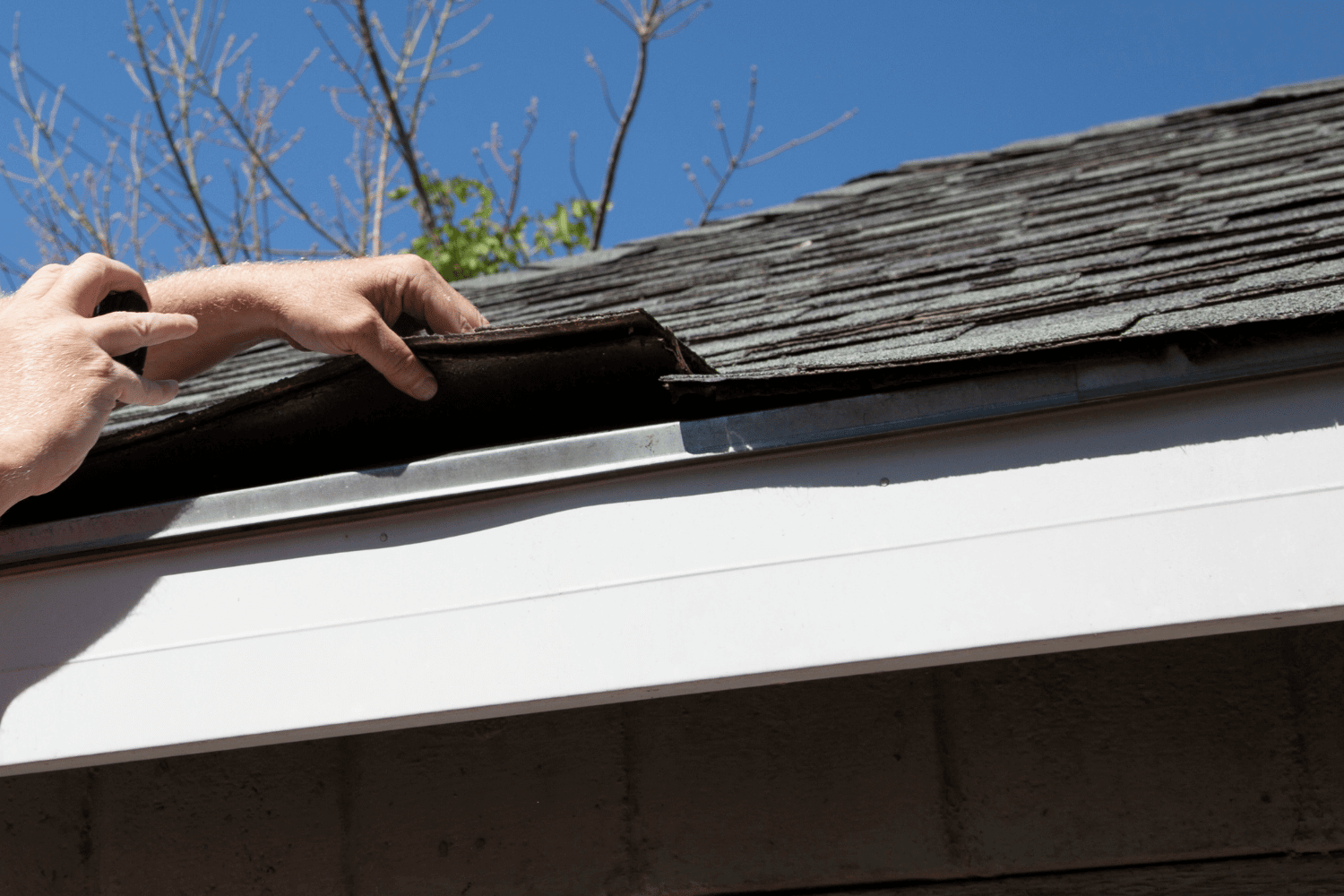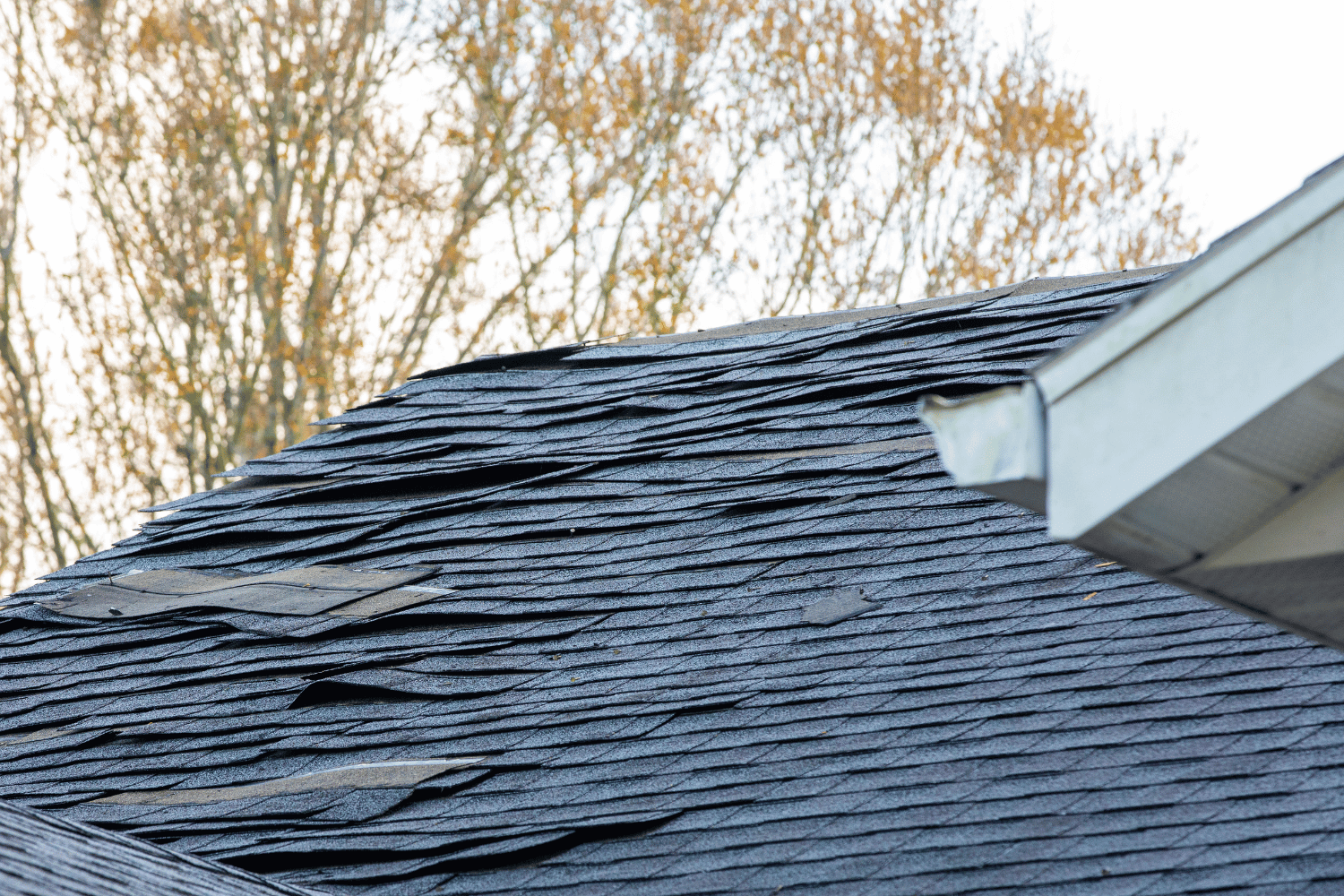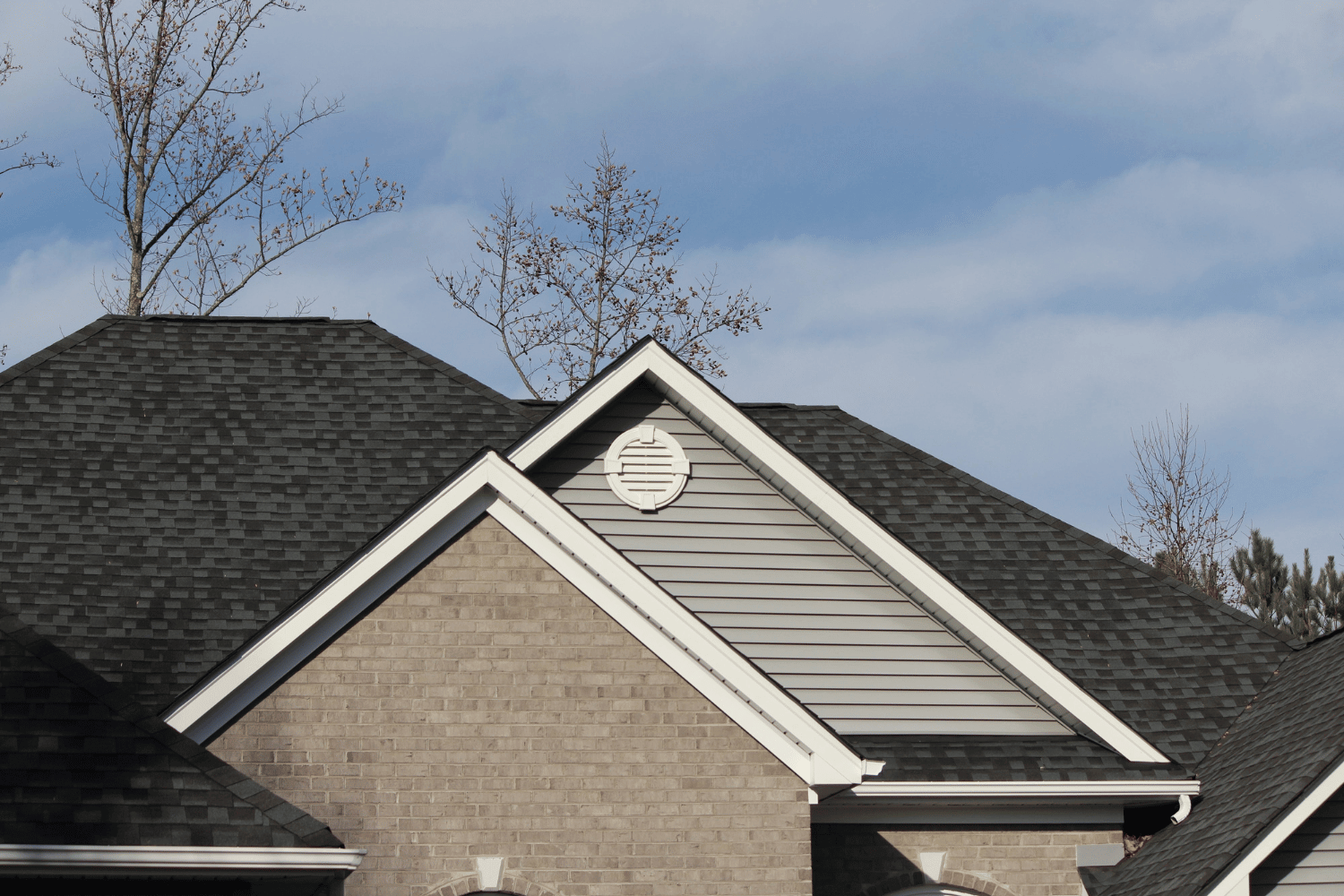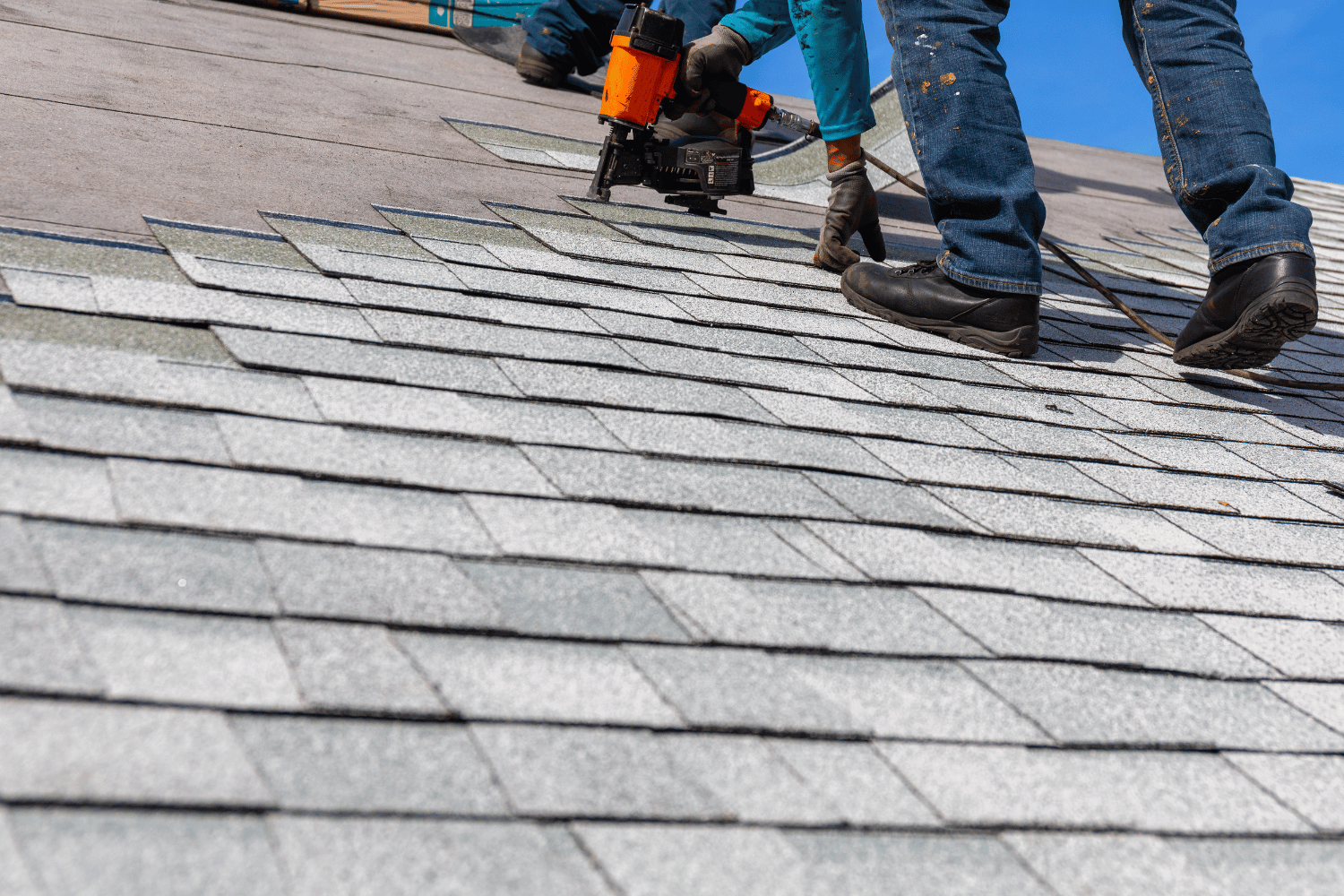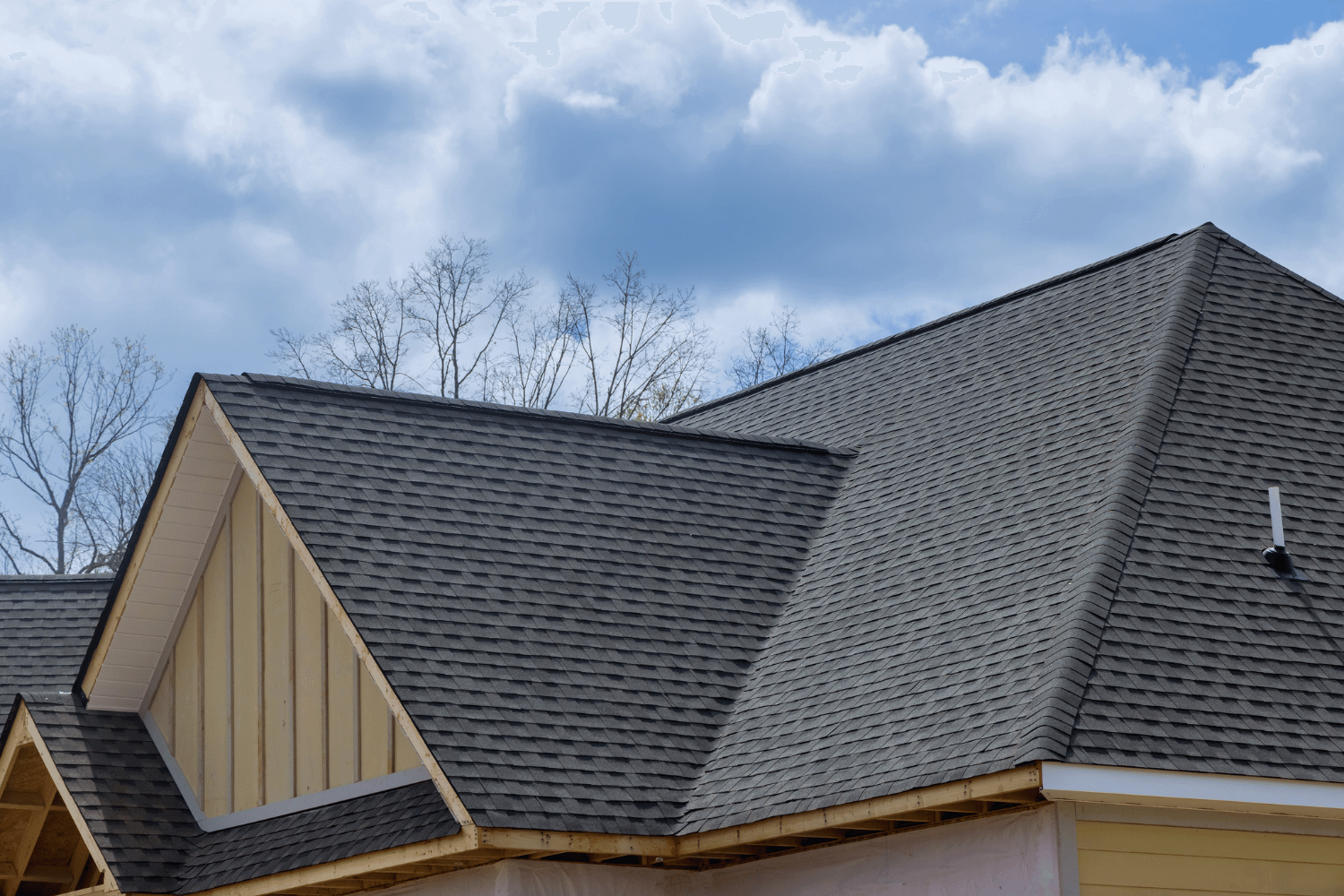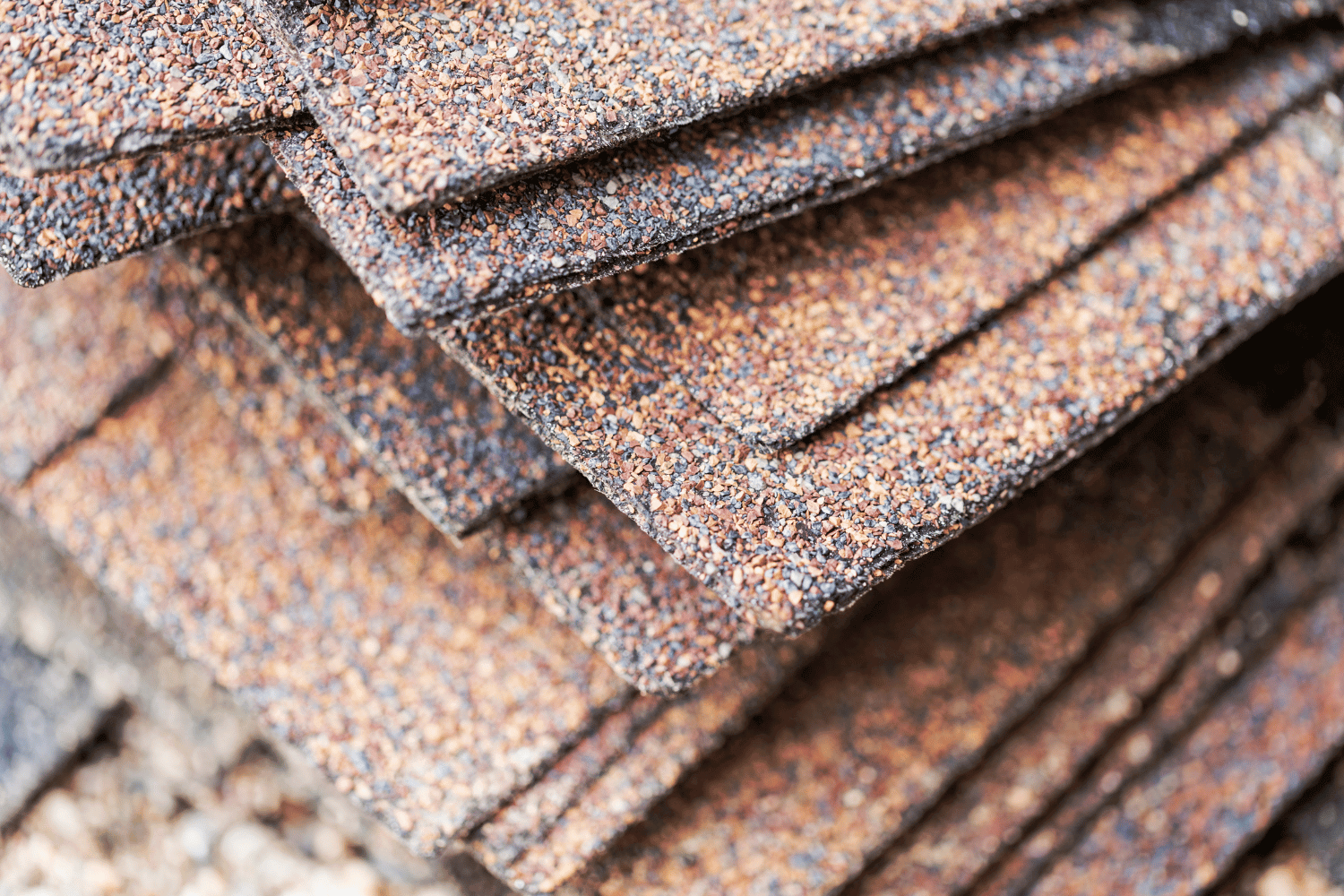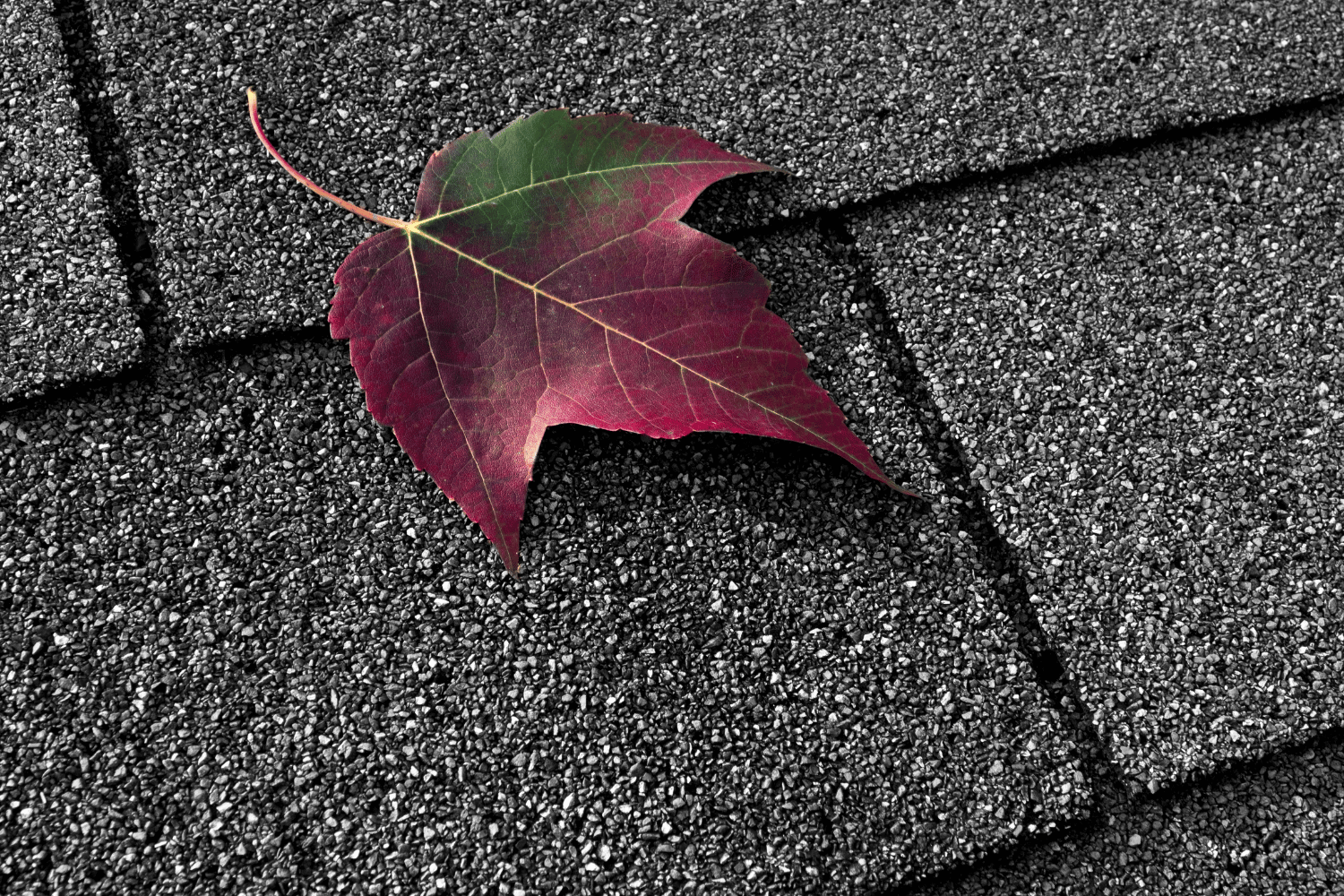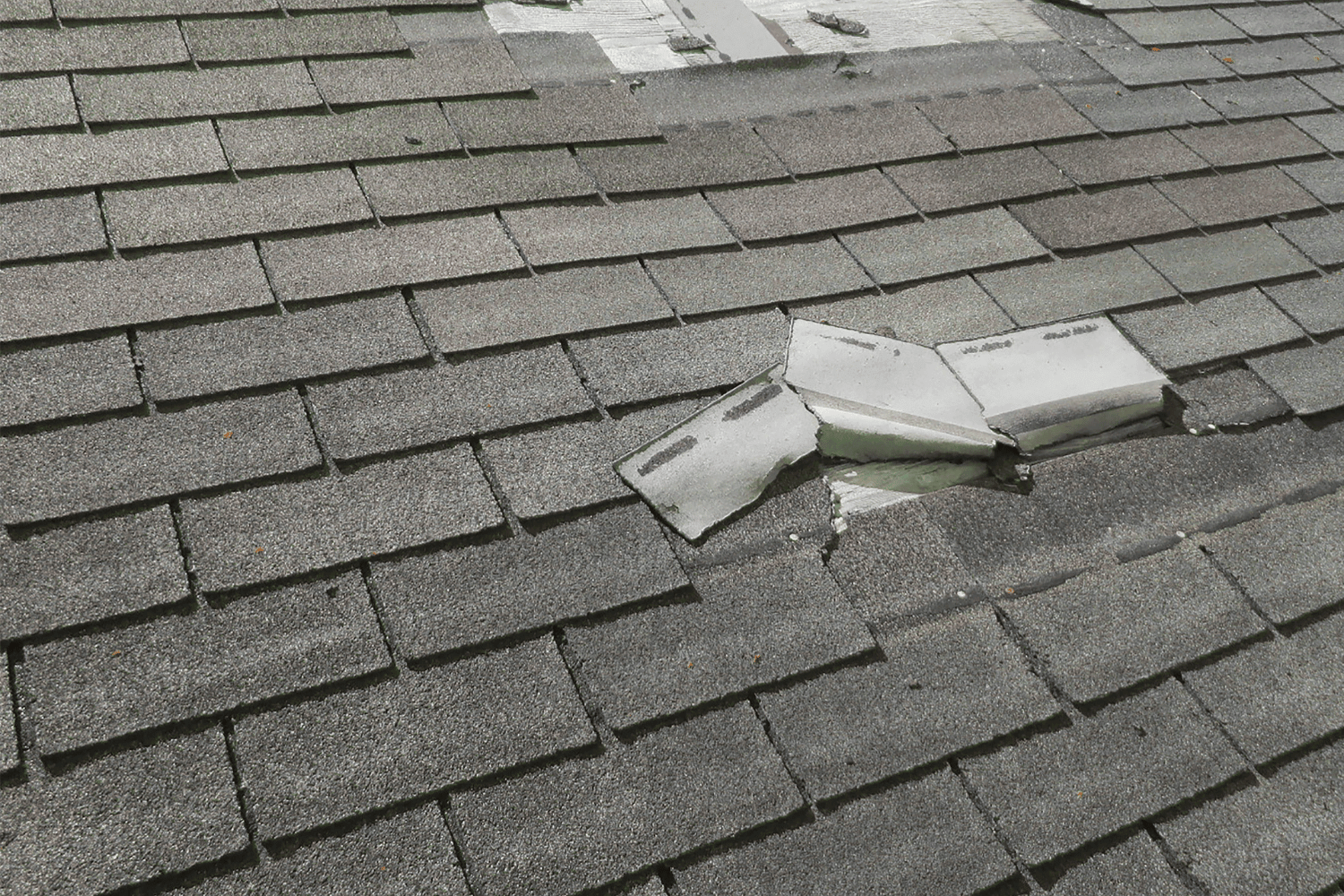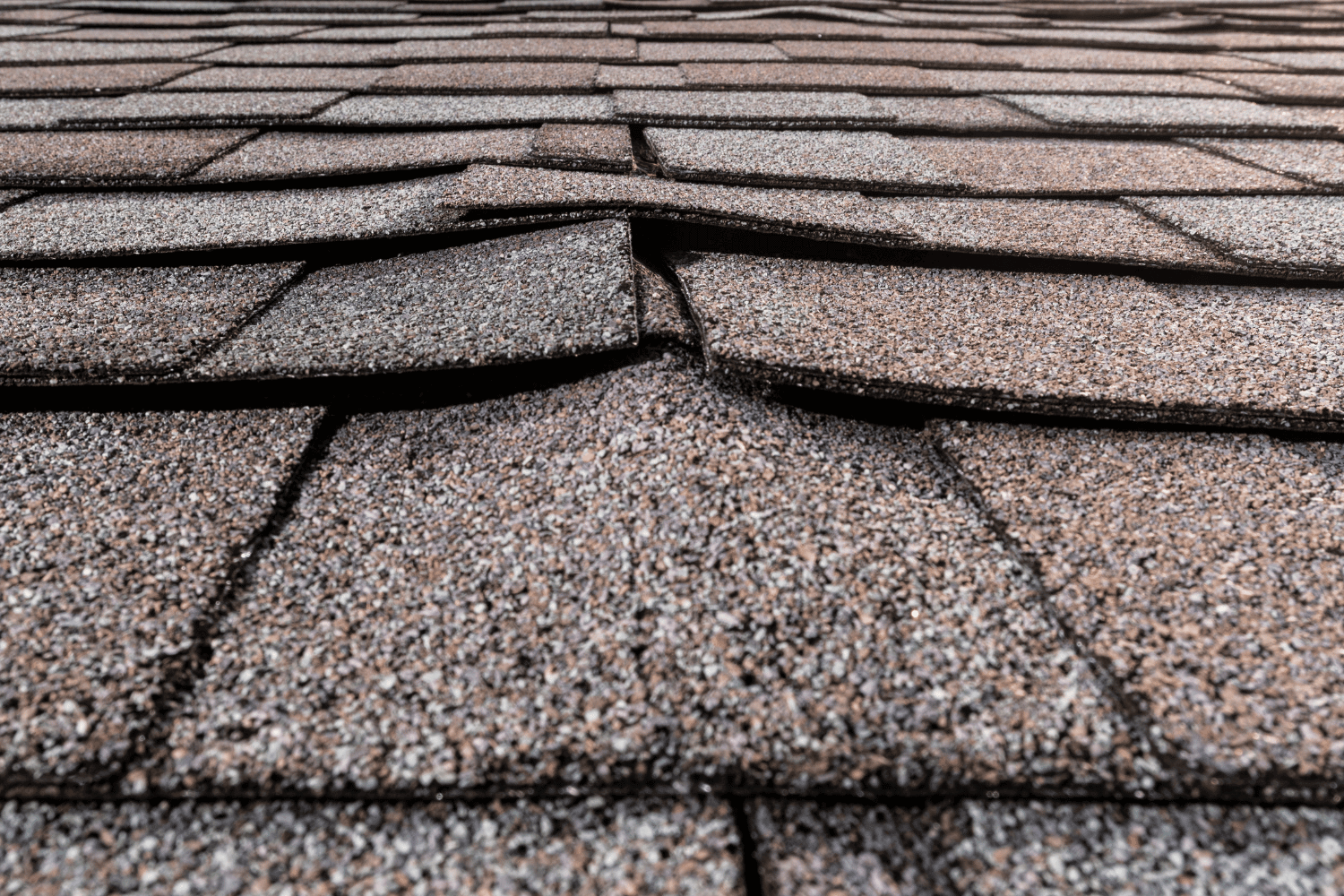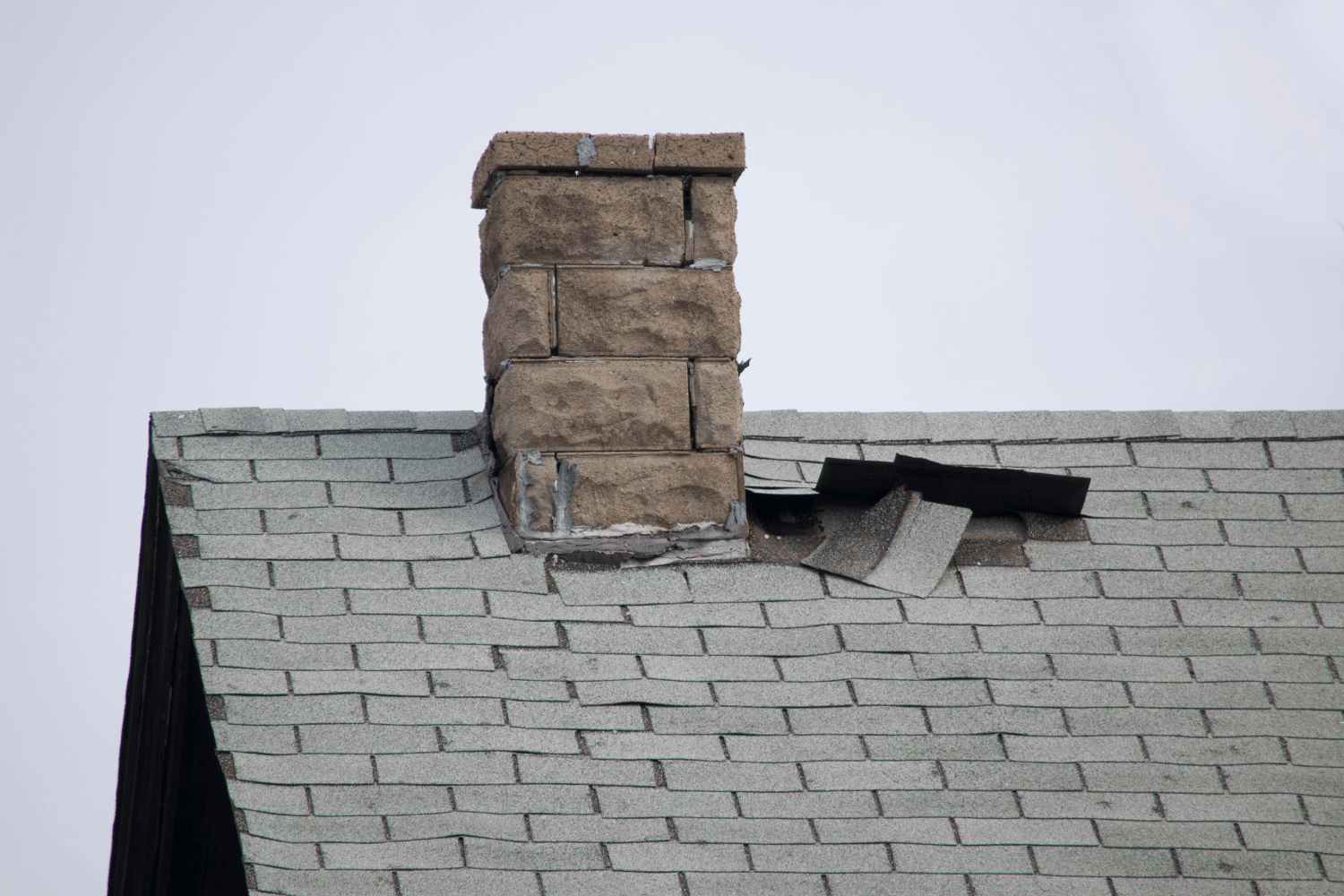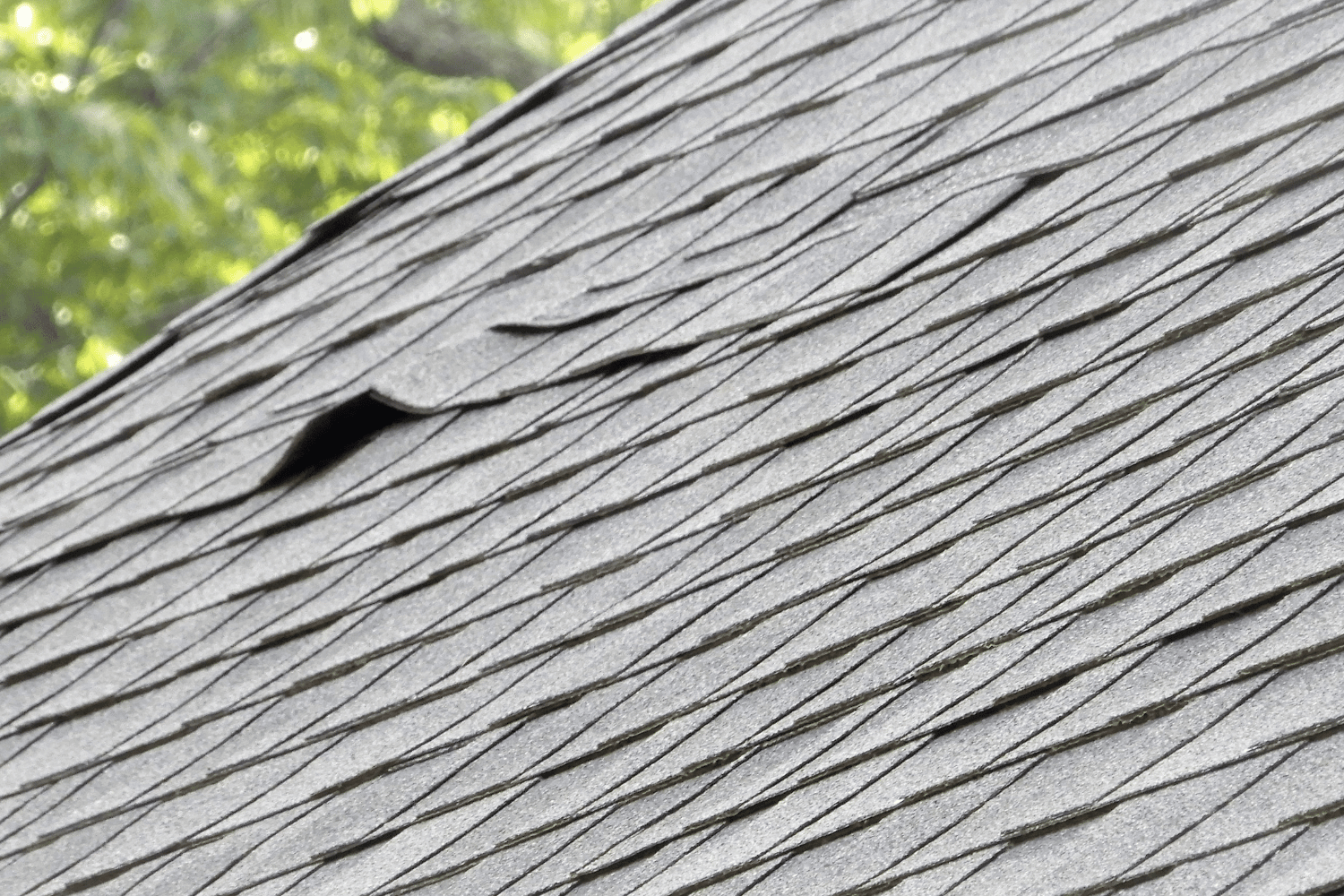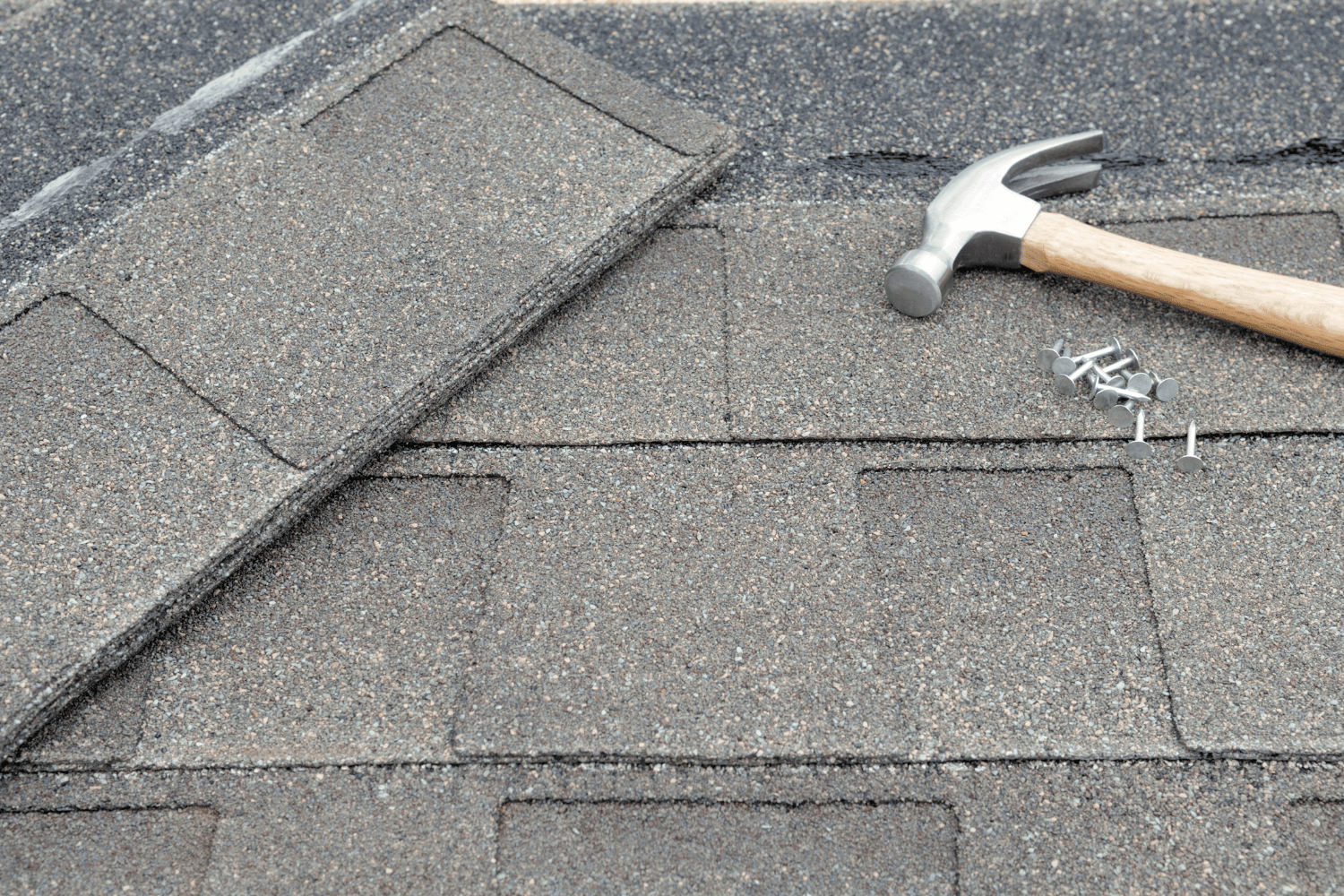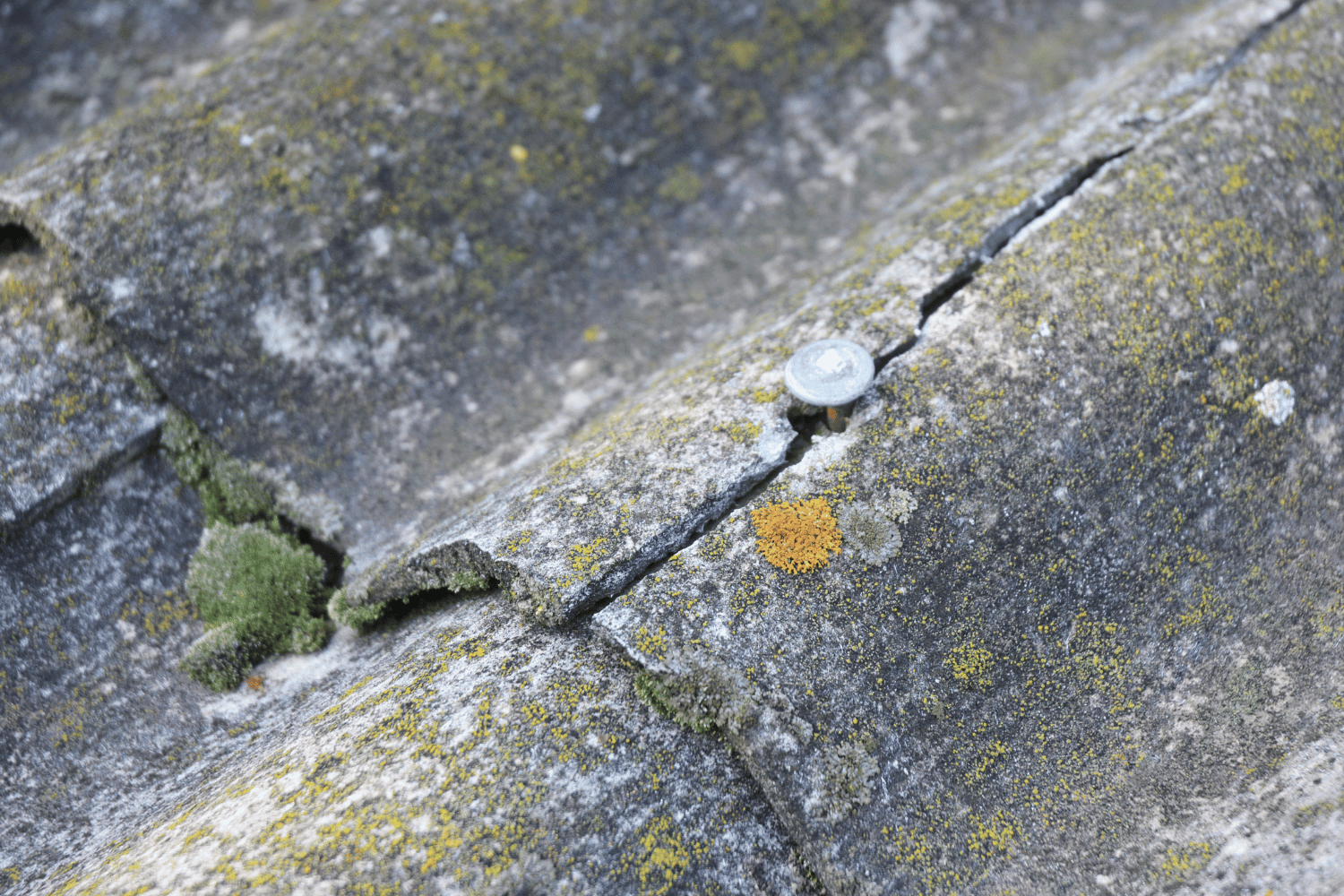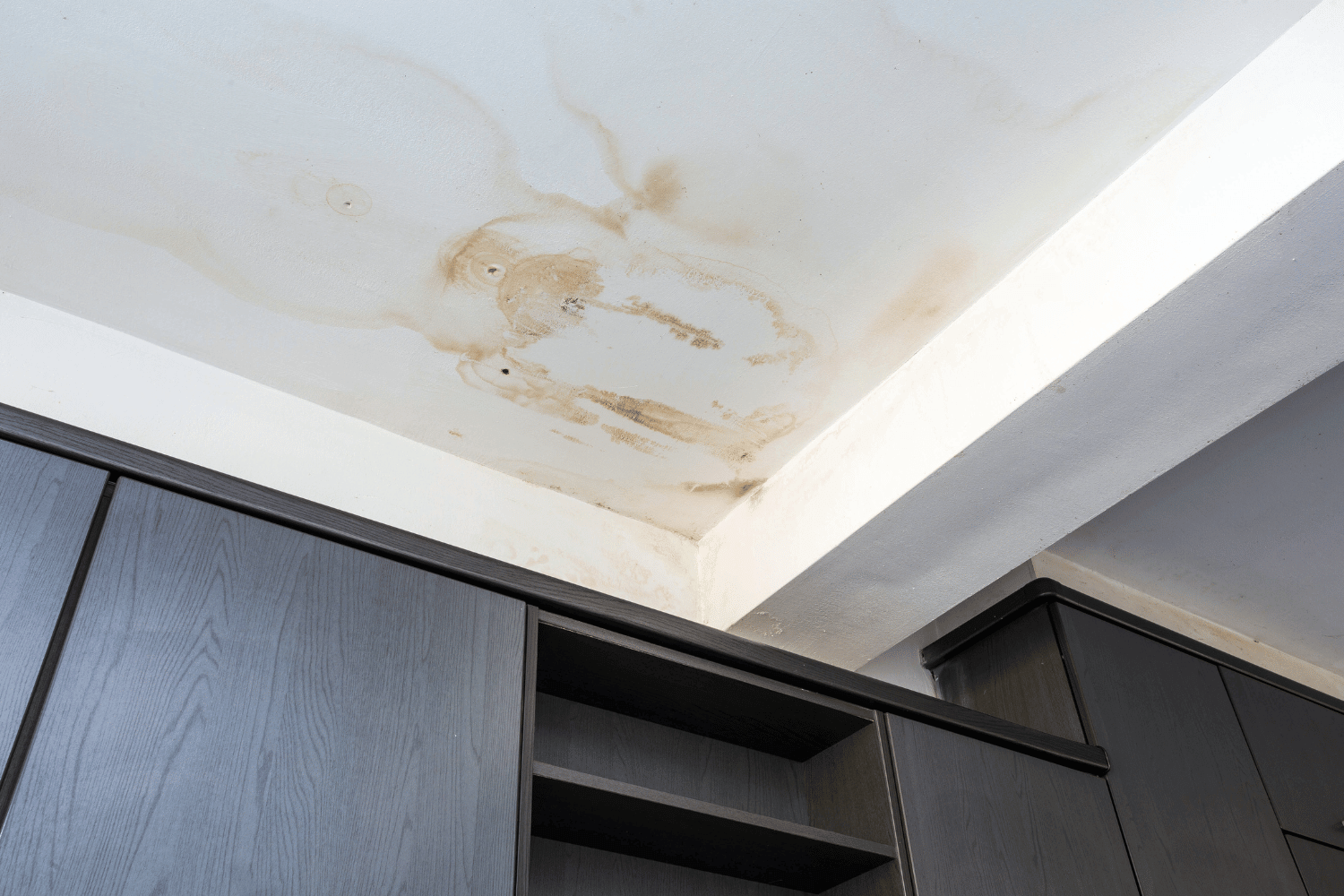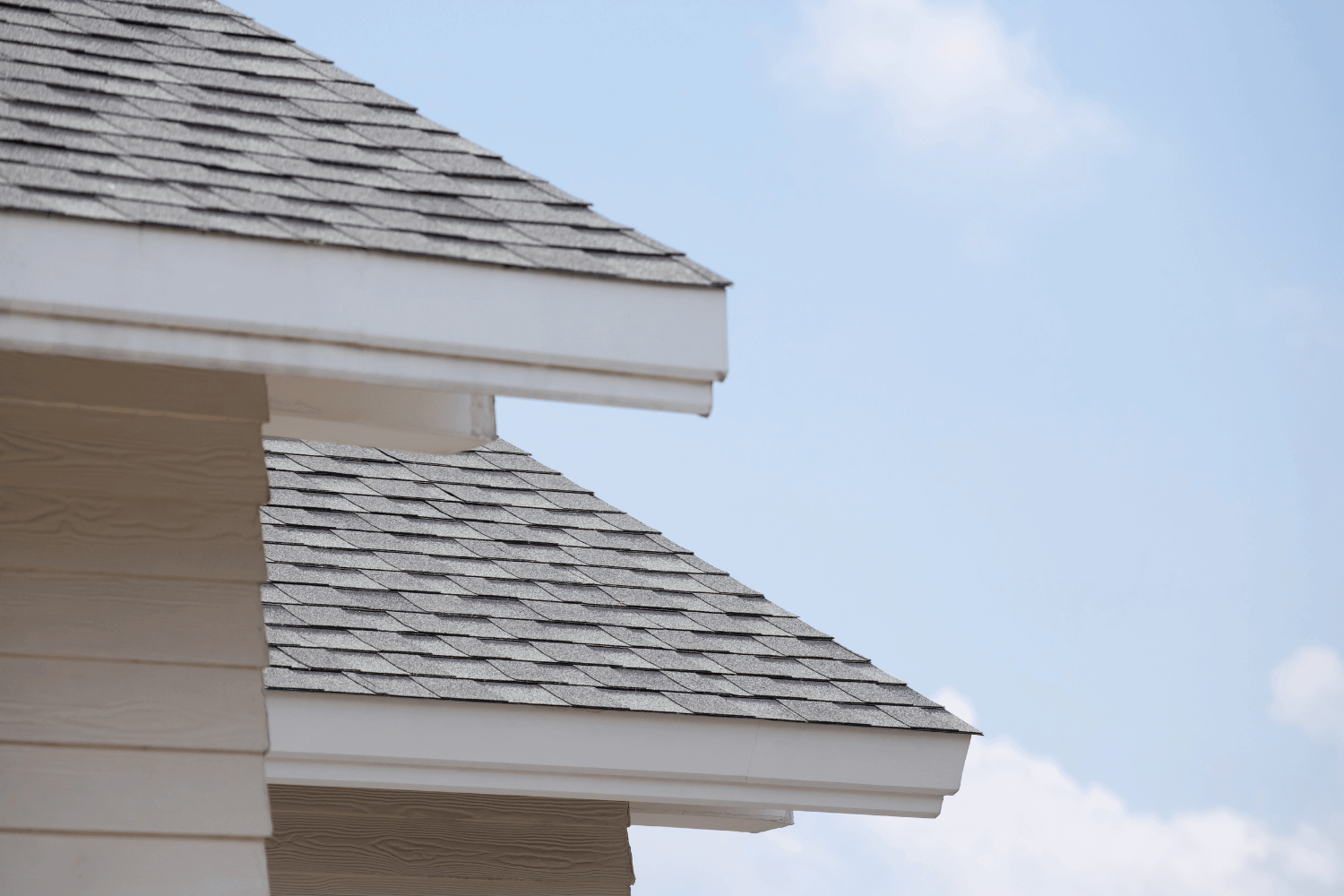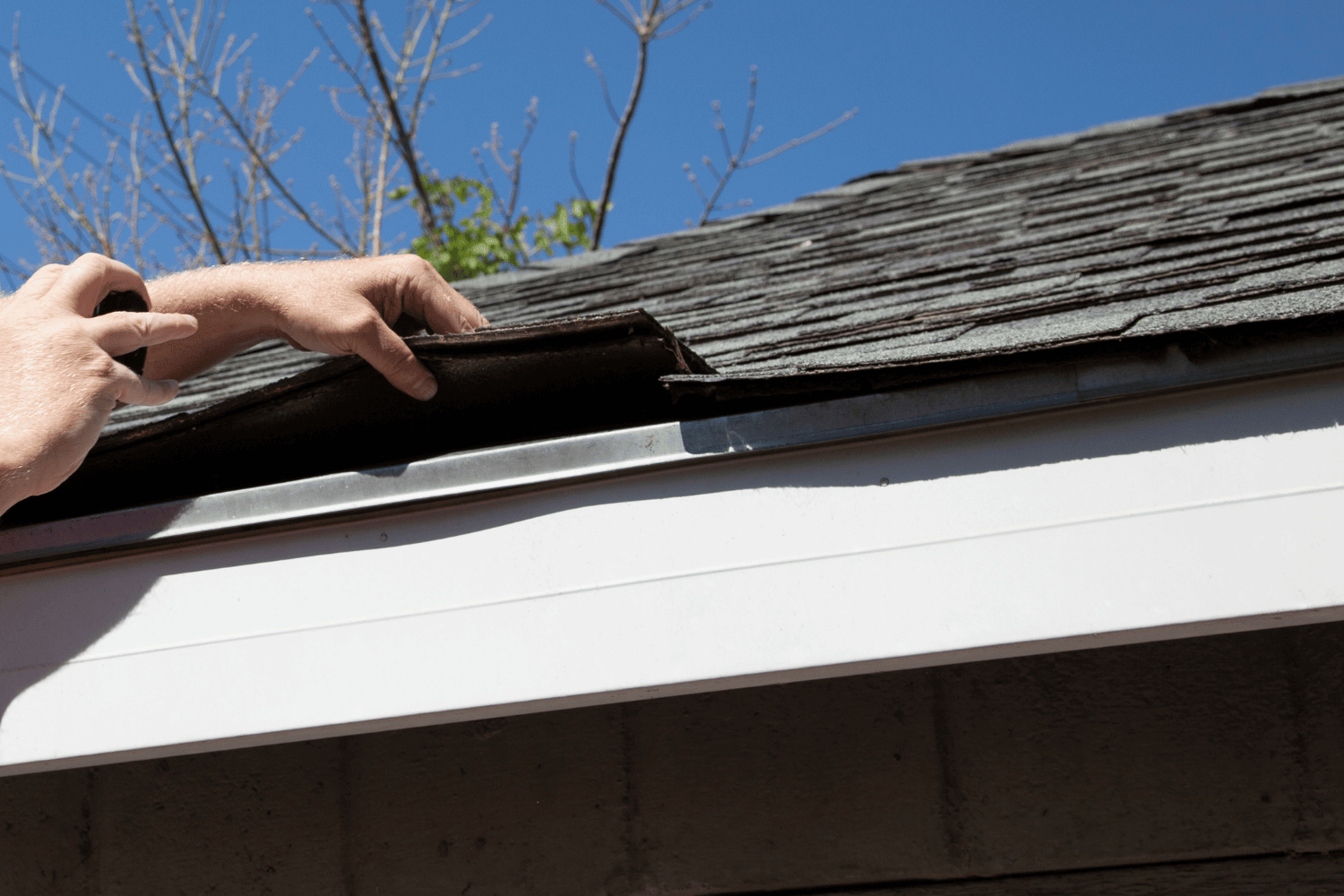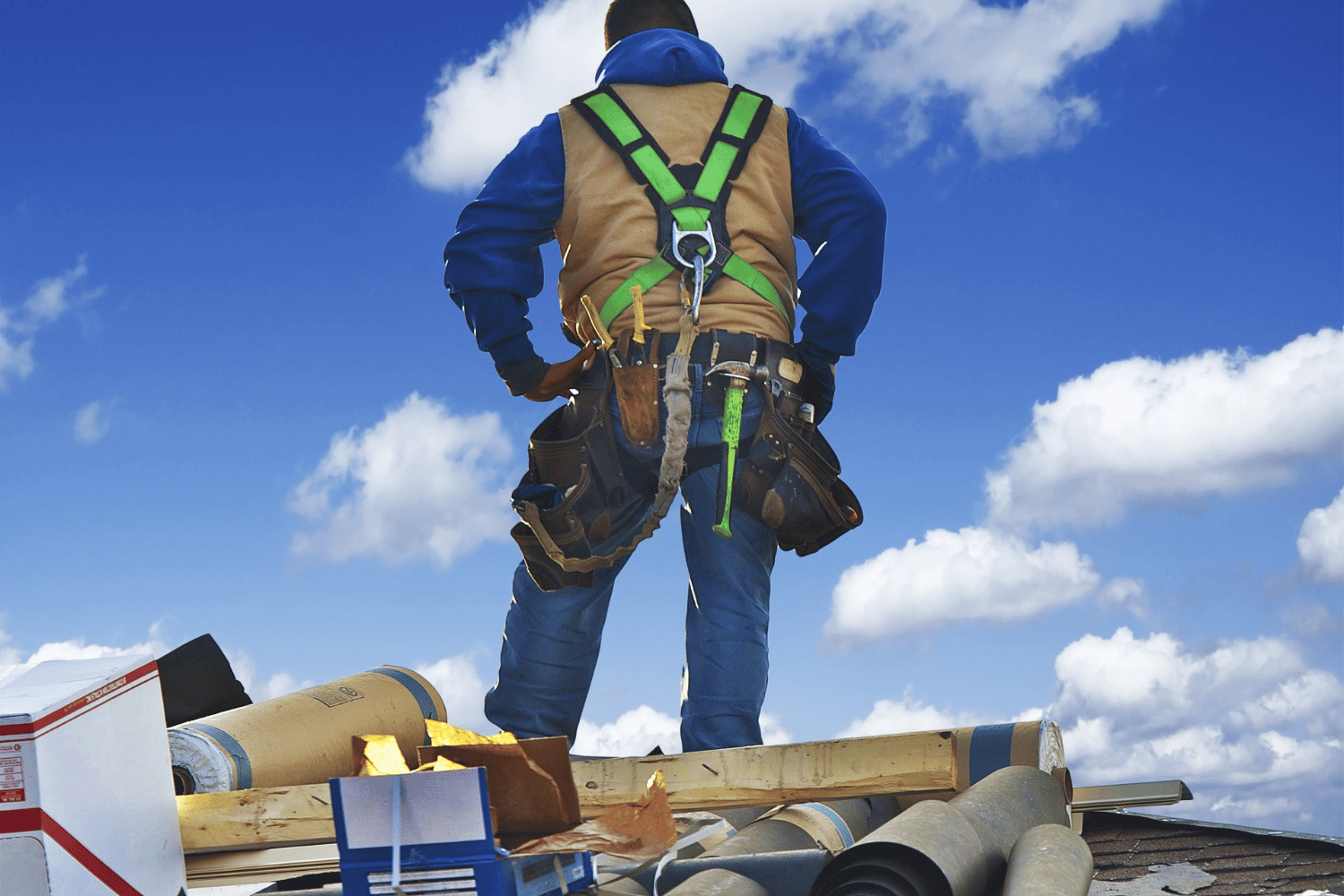What Supplies Are Needed to Replace a Roof? A Complete Checklist
Replacing a roof can seem overwhelming. To help, we’ve compiled a list of all the essential supplies needed to replace a roof. From tools to materials, this guide will ensure you’re fully prepared for a seamless roof replacement project.
Key Takeaways
-
Proper tools and safety equipment are essential for a safe and efficient roof replacement, including ladders, fall protection kits, and toe boards.
-
Selecting quality materials, like asphalt shingles and synthetic underlayment, is crucial for durability and protecting against weather damage.
-
Hiring professional roofers guarantees expertise and quality workmanship, enhancing the longevity of your roof and providing peace of mind.
Essential Tools for Roof Replacement
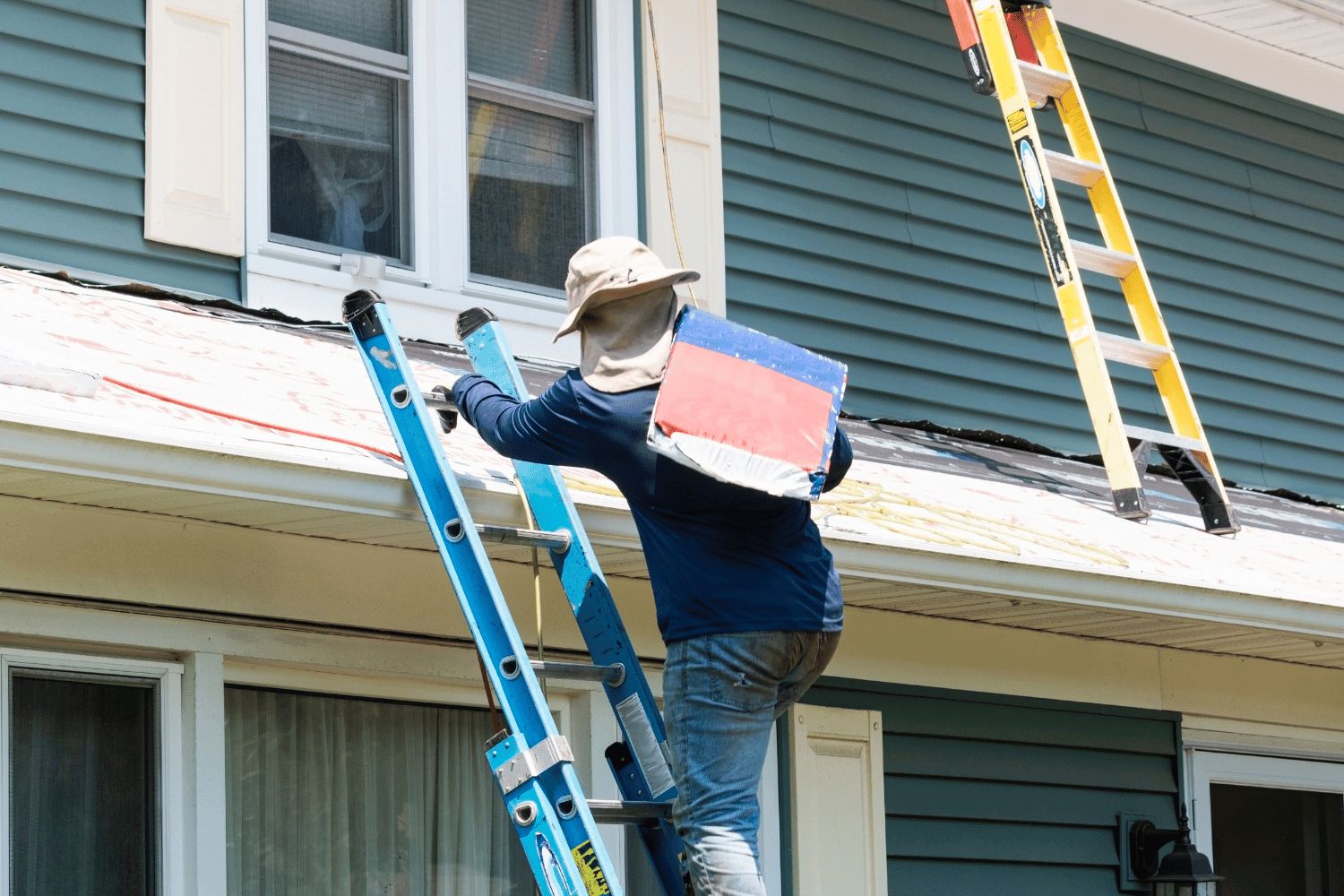
Embarking on a roof replacement without the proper tools is akin to cooking a gourmet meal without pots and pans. The right tools simplify the job and significantly boost safety and efficiency. Balancing on a steep roof without proper equipment can lead to serious injury. This makes having the right tools essential.
The right tools assist in safe roof access and perfect shingle alignment. Here are the must-have items for a smooth roofing project.
Ladder, Scaffold, or Shingle Lift
A sturdy ladder, scaffold, or shingle lift is vital for safe roof access. These tools offer a secure platform for roofers to reach elevated areas, especially on steep roofs. Carrying heavy materials like asphalt shingles up a flimsy ladder is both dangerous and inefficient. A scaffold or shingle lift makes this task safer and more manageable.
These tools provide the stability needed for effective roofing work, making them preferred by most roofers. Investing in a good ladder or scaffold is wise for both professionals and DIY enthusiasts.
Plus, using the proper safety equipment like hard hats and harnesses further ensures a safe and secure working environment.
Fall Protection Kit
Safety is paramount when working on a roof, making a fall protection kit essential. These kits typically include a reusable roof anchor, safety harness, rope lifeline, and shock-absorbing lanyard. They are designed to prevent falls and ensure that, in the event of a slip, you are securely anchored and safe from serious injury.
Having a fall protection kit keeps you safe and allows you to focus on the task at hand. Proper safety measures, including hard hats and utility knives, are crucial for any roofing project. Don’t skimp on safety; your life could depend on it.
Toe Boards
Toe boards are another critical safety feature, especially when working on steep roofs. These boards provide secure footing and prevent workers from slipping. Installing toe boards along the roof edges enhances safety and prevents tools and materials from falling, reducing the risk of injuries or property damage.
Balancing on a steep roof without support can be disastrous. Toe boards offer the stability needed for safe and efficient roofing tasks.
This simple yet effective safety measure is a must for any roofing project.
Demolition and Removal Tools
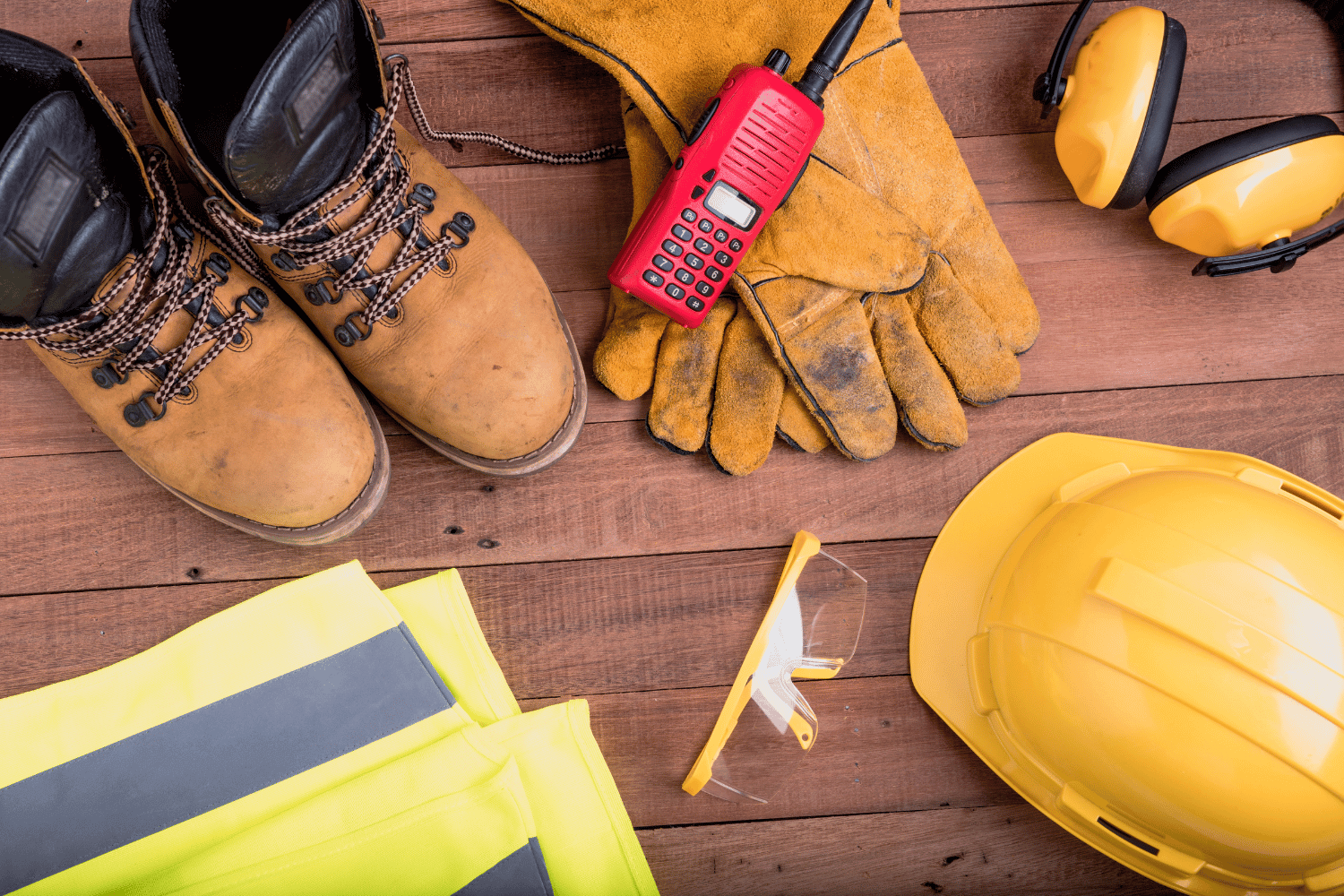
Removing old roofing materials is the first step before installing new ones. Demolition and removal tools are crucial for this phase. Prying off old shingles with bare hands would be extremely difficult and time-consuming.
The right tools expedite this task. Crowbars and flat head shovels are essential for any roof replacement project. Here are the tools you’ll need to remove old roofing.
Crowbar or Utility Bar
Crowbars and utility bars are essential during the demolition phase of roof replacement. They offer the leverage required to efficiently remove old nails and shingles. Imagine trying to pull out stubborn nails without the proper tool—it would be a frustrating and time-consuming task.
Using a crowbar or utility bar makes the removal process more manageable and less strenuous. These tools are designed to make quick work of even the most stubborn old roofing materials, streamlining the entire project.
Flat Head Shovel
A flat head shovel is crucial for removing old shingles. It lifts and removes shingles quickly, speeding up the demolition phase. Imagine trying to scrape off old shingles with a regular shovel—it would take forever and likely damage the roof deck.
Using a flat head shovel allows you to efficiently remove old roofing materials without causing unnecessary damage. This tool is a must-have for anyone tackling a roof replacement project.
Installation Tools
With the old roof removed, installing new roofing materials begins. The right installation tools ensure proper alignment and secure fastening. Without a nail gun or hammer, achieving a professional finish would be nearly impossible.
From hammers to chalk lines, these tools are essential for the installation phase. Let’s explore the tools you’ll need to ensure a smooth and successful installation process.
Hammer or Roofing Nailer
For securing shingles, a hammer or roofing nailer is indispensable. While a hammer is useful for small tasks, a roofing nailer is preferred by most roofers for its speed and efficiency. Imagine trying to nail each shingle by hand—it would take forever and wear you out quickly.
A roofing nailer ensures that each nail is driven in with the perfect amount of force, providing a secure and durable attachment. This tool is essential for achieving a professional finish and ensuring the longevity of your new roof.
Chalk Line
A chalk line is an effective tool for straight shingle installation. Snapping a chalk line creates a guide for perfect alignment of each shingle row. Imagine trying to install shingles without any guide—it would be nearly impossible to keep everything straight.
Using a chalk line ensures that your shingles are installed in straight, even rows, which not only looks better but also helps prevent leaks. This tool is a must-have for any roofing project.
Utility Knife
A utility knife, especially one with a hook blade, is essential for making precise cuts in shingles and underlayment. This tool allows you to trim materials to fit perfectly around roof edges and other obstacles. Imagine trying to cut shingles with a regular knife—it would be difficult to achieve clean, accurate cuts.
A utility knife with a hook blade offers better control and precision, ensuring perfect fitting of roofing materials. This tool is essential for any roof replacement project.
Key Roofing Materials

With the right tools in hand, focus shifts to the key roofing materials needed for replacement. These materials are the backbone of your new roof, offering durability, protection, and aesthetic appeal. Replacing your roof without knowing the essential materials would be like baking a cake without knowing the ingredients.
From asphalt shingles to synthetic underlayment, let’s explore the key roofing material that will ensure your roof stands the test of time.
Asphalt Shingles
Asphalt shingles are the most popular choice for roofing due to their low cost, durability, and design flexibility.
Asphalt shingles are primarily categorized into three types:
-
3-Tab shingles, which offer a traditional look
-
Architectural shingles, which provide a more dimensional appearance
-
Luxury shingles, which have a premium appearance and enhanced durability
Each type offers different benefits, catering to various aesthetic preferences and budget considerations.
Selecting the right asphalt shingles significantly impacts your roof’s longevity and appearance. Most roofers recommend architectural shingles for their durability and aesthetic appeal. These shingles are designed to provide a dimensional look, adding depth and character to your roof.
Synthetic Underlayment
Synthetic underlayment is vital for any roof replacement project. It prevents moisture from reaching the roof decking, offering protection from water damage. Compared to traditional felt paper, synthetic underlayment is more durable and offers better water repellence.
Synthetic underlayment keeps your roof protected from moisture, preventing leaks and extending its lifespan. This material is essential for any roofing project.
Drip Edge
A drip edge protects roof edges from water damage. It directs water away from the fascia and into the gutters, preventing seepage under the shingles. Installing a drip edge is a small step that greatly extends your roof’s lifespan by preventing water damage and leaks.
Tin snips allow you to cut the metal drip edge to the required length and install it along roof edges. This simple component ensures proper water drainage and maintains the roof system’s integrity.
Protective Elements
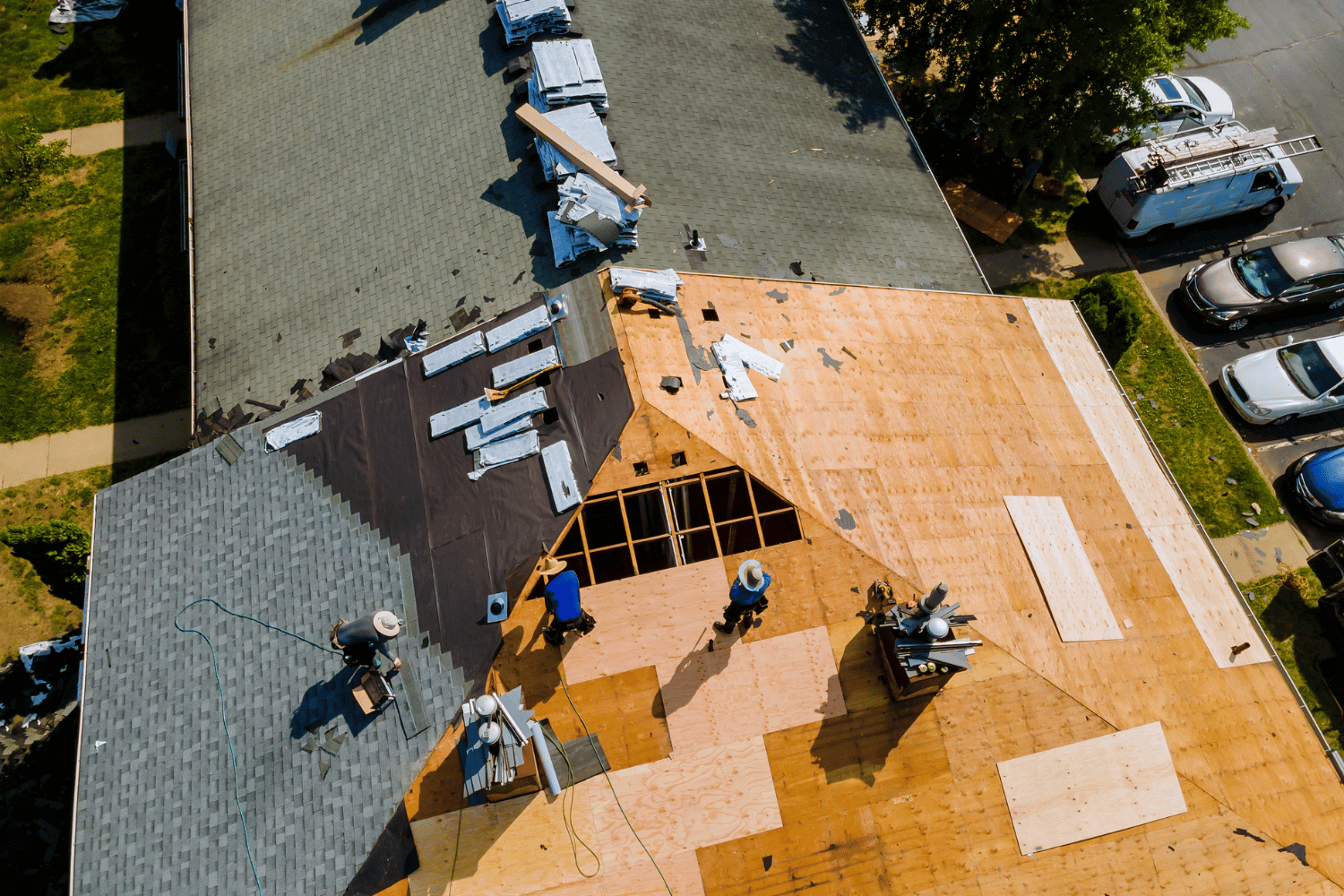
Protective elements are crucial for ensuring that your roof can withstand the elements and prevent leaks. Components like ice and water shields, flashing, and pipe boots offer extra protection to vulnerable roof areas. Installing a new roof without these protective elements would almost certainly lead to water damage and leaks.
Let’s explore the key protective elements that will keep your roof in top condition for years to come.
Ice and Water Shield
Ice and water shields protect your roof from damage, especially in regions with heavy snowfall. Installed along roof edges and valleys, they prevent leaks caused by ice dams and water infiltration.
Building codes often mandate ice and water shields in specific areas to protect roofs during harsh weather. This element is essential for roof replacement projects in colder climates.
Flashing
Flashing prevents water infiltration around roof penetrations like chimneys, vents, and valleys. Made from materials like aluminum, steel, or copper, it directs water away from vulnerable areas, preventing leaks and damage.
Properly installed flashing is crucial for your roof’s longevity. It should be replaced with a new roof to ensure effective performance. This small but vital element plays a significant role in maintaining a leak-free roof.
Pipe Boots
Pipe boots are specialized flashing used to seal around roof ventilation pipes. They prevent water from seeping through pipe openings, crucial for avoiding leaks and water damage.
Neoprene pipe boots are popular for their durability and effectiveness. However, they need to be replaced about every decade to ensure a watertight seal and prevent roof leaks. This simple maintenance step can significantly prolong the life of your roof.
Ventilation and Insulation Components
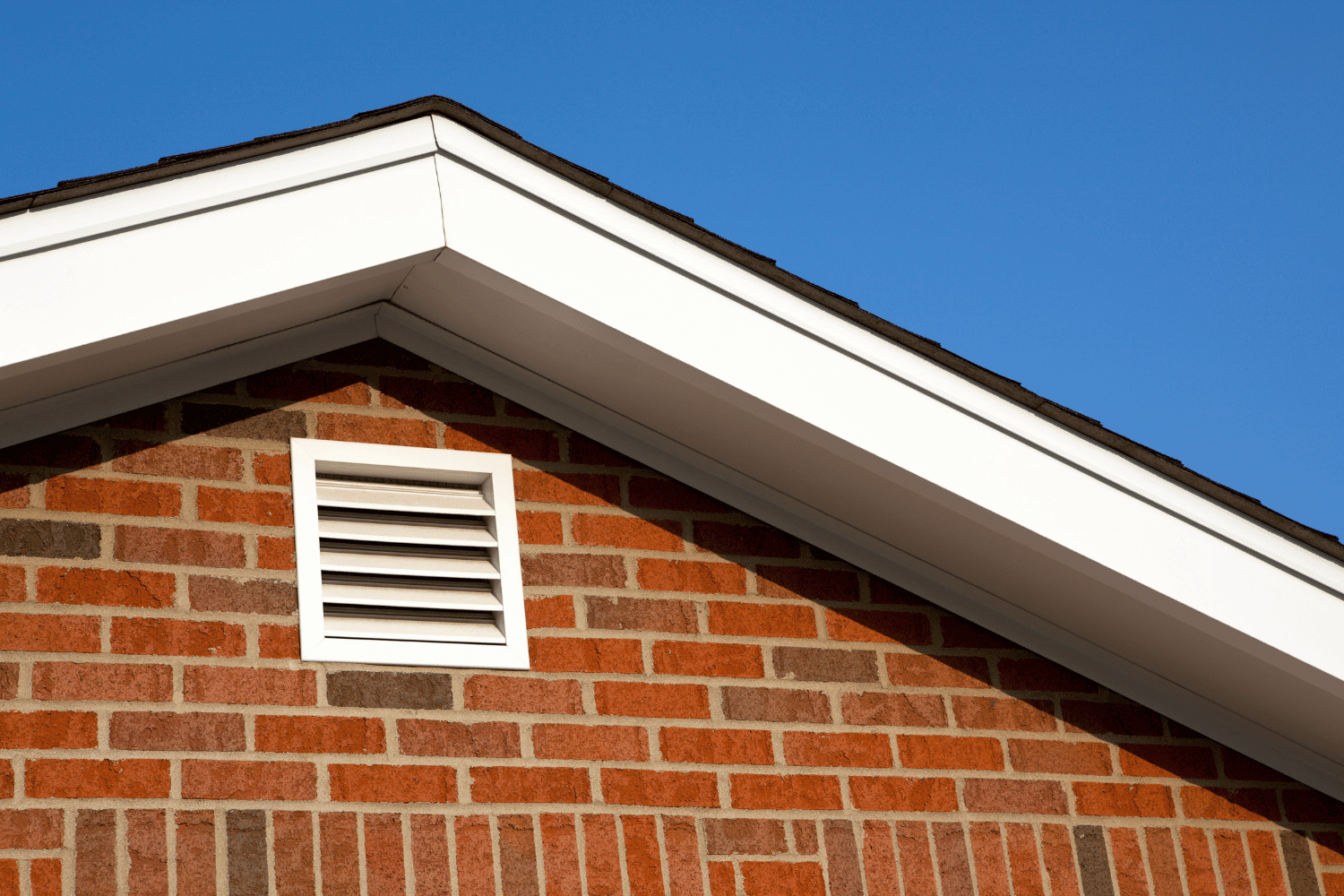
Proper ventilation and insulation are crucial for a healthy roof system. Inadequate ventilation can turn your attic into a breeding ground for mold and mildew, causing structural damage and higher energy bills. Repairing extensive mold damage due to poor roof ventilation can be costly.
Let’s explore the components that ensure your roof remains well-ventilated and insulated.
Roof Vents
Roof vents regulate attic temperature and reduce humidity, facilitating airflow to prevent moisture buildup that can cause mold and structural damage. Properly installed roof vents are essential for maintaining a healthy roof and attic.
When installing roof vents, make sure to secure them properly and seal around the edges to prevent leaks. A well-ventilated attic extends your roof’s life and helps lower energy costs by maintaining a stable indoor temperature.
Ridge Cap Shingles
Ridge cap shingles, used at the roof’s peak, provide wind resistance and complete the roof system. They cover the ridge and help prevent wind-driven rain from entering.
Properly installing ridge cap shingles enhances your roof’s appearance and provides additional protection against the elements. This crucial step ensures a secure and leak-free roof.
Safety Equipment
Safety is paramount when working on a roof, and the right safety equipment prevents accidents and injuries. OSHA mandates personal fall arrest systems for work at heights, making safety equipment essential for any roofing project. Working on a steep roof without safety measures is a recipe for disaster.
Let’s explore the key safety equipment that will keep you protected during your roof replacement project.
Hard Hats
Hard hats protect workers from head injuries caused by falling debris and accidental impacts. These helmets absorb shocks and provide a crucial barrier against head injuries when working at heights.
Wearing a hard hat is a simple and effective way to prevent serious injuries. This essential safety equipment should be worn at all times during roofing work to ensure a safe environment.
Safety Harnesses
Safety harnesses prevent falls, especially on steep roofs. They provide secure attachment points and support, reducing the risk of serious injuries. Losing your footing on a steep roof without a harness could result in a life-threatening fall.
Safety harnesses ensure secure anchorage and protection while working at heights. This essential safety measure is a must for any roofing project to ensure the crew’s safety and well-being.
Preparing for the Project
Proper preparation is key to a successful roof replacement project. From obtaining the necessary permits to coordinating material delivery, preparation ensures that the project runs smoothly and efficiently. Imagine starting a roofing project without any preparation—it would be chaotic and prone to delays.
Let’s explore the steps you need to take to prepare for your roof replacement project.
Material Delivery
Coordinating the delivery of roofing materials is crucial for ensuring a smooth installation process. Ideally, materials should be delivered one to two days before the installation begins to allow for timely preparation. Storing materials in a dry area prevents damage and ensures they are ready for use.
Proper coordination and storage of roofing materials are essential for a successful roofing project. This simple step can prevent delays and ensure that the installation process goes smoothly.
Site Preparation
Preparing the worksite is another crucial step before starting the roof installation. This involves laying down tarps to protect the ground and catch debris, as well as covering plants and landscaping to prevent damage. Informing your neighbors about the project also helps them prepare for the noise and activity.
Proper site preparation ensures that the surroundings are protected and the project can proceed without unnecessary interruptions. This step is essential for a smooth and efficient roof installation process.
Hiring Professional Roofers
While DIY roof replacement can be tempting, hiring professional roofers offers numerous benefits. Professional roofers possess the necessary training and equipment to ensure high-quality work, reducing the risk of costly mistakes and ensuring proper installation. Imagine the peace of mind knowing that your roof is being handled by experts.
Let’s explore the benefits of hiring professional roofers and how it can enhance the quality and longevity of your roof.
Expertise and Quality
Hiring professional roofers provides peace of mind through their expertise and assurance of quality workmanship. Reputable roofing contractors and a skilled roofing contractor have the skills and experience needed to ensure proper installation of roofing materials, which greatly enhances the roof’s longevity and reliability.
Quality workmanship from experienced roofers leads to reduced future repair costs and increased property value. This investment in professional expertise ensures that your roof replacement project is done right the first time.
Satisfaction Guaranteed
At Dream Home Roofers, customer satisfaction is our top priority. We offer a satisfaction guarantee, promising to address any concerns after the project’s completion. Our focus on quality and diligence ensures that every roofing project meets high standards and yields guaranteed results.
Through thorough consultation and communication, we understand and meet our clients’ needs, ensuring they are completely satisfied with our roofing work. This commitment to customer satisfaction sets us apart and ensures a seamless and professional experience for every homeowner.
Summary
In summary, a successful roof replacement project requires the right tools, materials, and safety equipment. From essential tools like ladders and nailers to protective elements like flashing and pipe boots, each component plays a crucial role in ensuring the longevity and durability of your new roof. Proper preparation and the expertise of professional roofers further enhance the quality of the installation.
By following this comprehensive checklist, you can ensure a smooth and efficient roof replacement process. Remember, investing in the right supplies and professional expertise will pay off in the long run, providing you with a roof that stands the test of time.
Frequently Asked Questions
What discount is currently being offered on materials for roof replacements?
You can snag fantastic discounts for roof replacements with Dream Home Roofers! It’s a great time to save on that project you’ve been considering. Check out our current specials!
What type of roofing materials does Dream Home Roofers work with?
Dream Home Roofers primarily uses premium Owens Corning roofing materials, ensuring quality and durability for your roof. You’re in good hands with their top-notch selections!
How can I set up a free consultation with Dream Home Roofers?
To set up a free consultation with Dream Home Roofers, just give them a call at 1-888-513-9184. It’s that simple!


